There are so many temples in Bali that she is often referred to as ‘the island of the Gods’. So when in Bali, it is pretty much essential to visit one.
It is always a serene sight to see Balinese people place offerings and pray. Even when it’s a ‘regular’ house temple which you can find in every family compound.
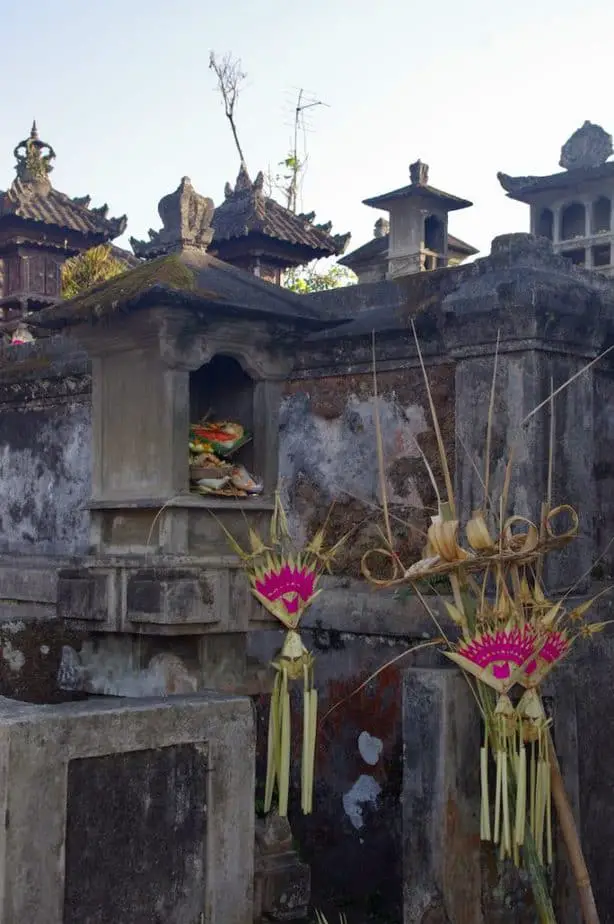
In this article, you can find all the ins and outs of Hindu temples in Bali. This short introduction is helpful to fully appreciate the complexity and the importance of the temples to the Balinese people.
The Balinese word for temple is Pura. It is derived from Sanskrit and means ‘walled enclosure’. A temple is seen as a ‘home’ between heaven and earth for the gods. It is of great importance to the Balinese to maintain it, decorate it with carvings, conduct ceremonies, and place offerings.
“How many temples are there in Bali?”
There are countless temples in Bali, some say over 50.000. It might sound impossible but every family compound has one. Each village has to have at least three so there might be even more than 50.000.
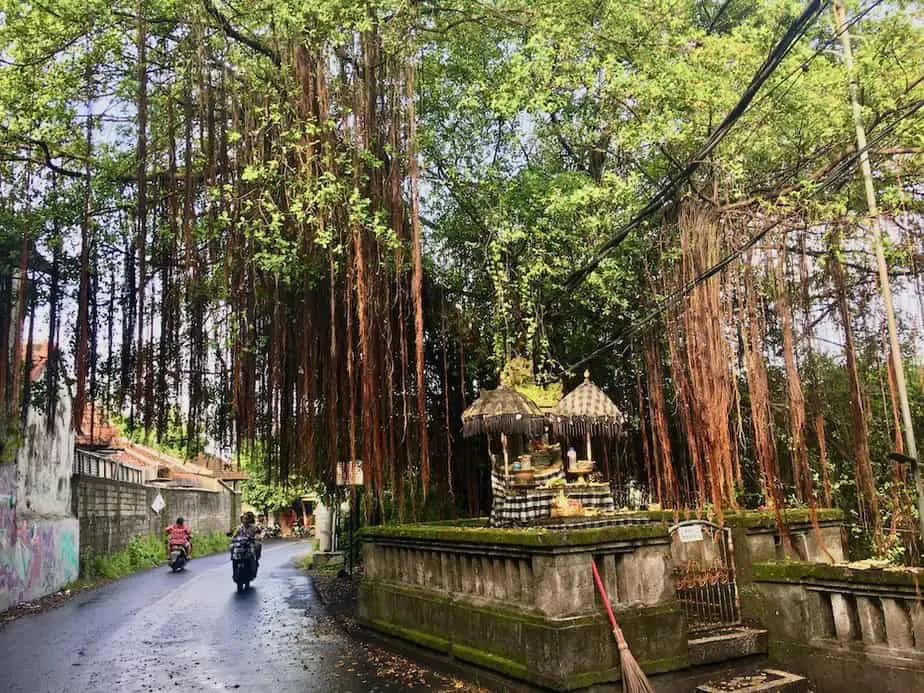
These large numbers might feel a bit daunting. But you will pass several without realizing it. Temples come in all forms and sizes and are found everywhere: rice paddies, markets, beaches, mountains, caves, along rivers, etc.
The Balinese place offerings every day on shrines found in temples, at their family compound, and even on the sides of the streets. Some shrines are even temporary such as those at a construction site or in the ricefields.
They are dedicated to the gods and deities; the good ones or the bad ones.
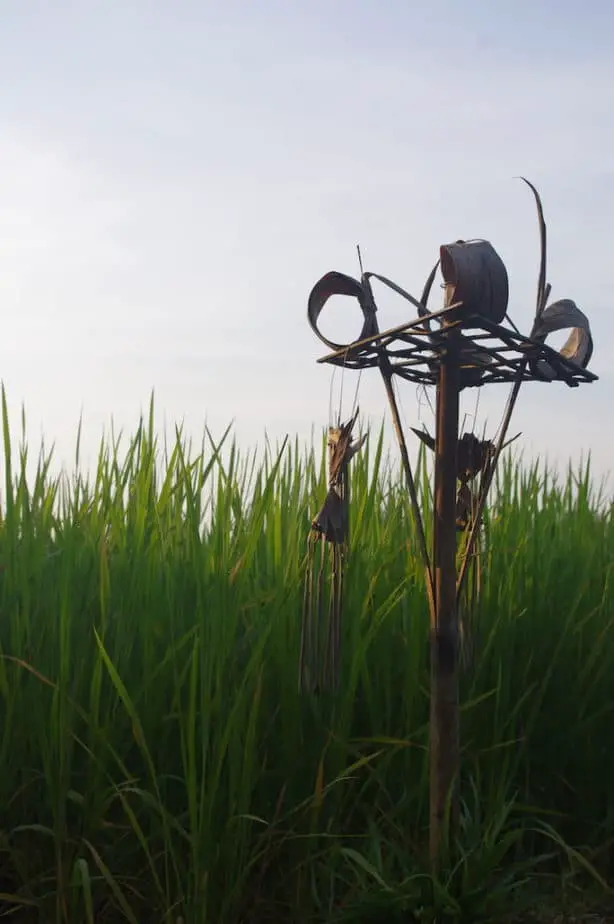
What types of Temples in Bali are there?
There a many types of temples in Bali. The religious and symbolic meaning is complex. We will only cover the ‘basics’ so you will recognize and somewhat understand the temples when visiting Bali.
You can divide Balinese temples into 5 categories:
- village temples
- occupation temples
- ancestral temples
- directional temples
- sea temples.

The Village Temples in Bali
As mentioned before each village in Bali has at least three temples. These temples are called Tri Kahyangan Temples. One of them is the Pura Puseh, known as the temple of origin. It is located in the north of the city, kaja. Kaja is the holiest direction which is towards the mountains from where the water starts flowing.
This temple always faces the sacred Mount Agung, the mountain where the gods live. This temple is dedicated to the god Vishnu (the Preserver) and the founders of the village.
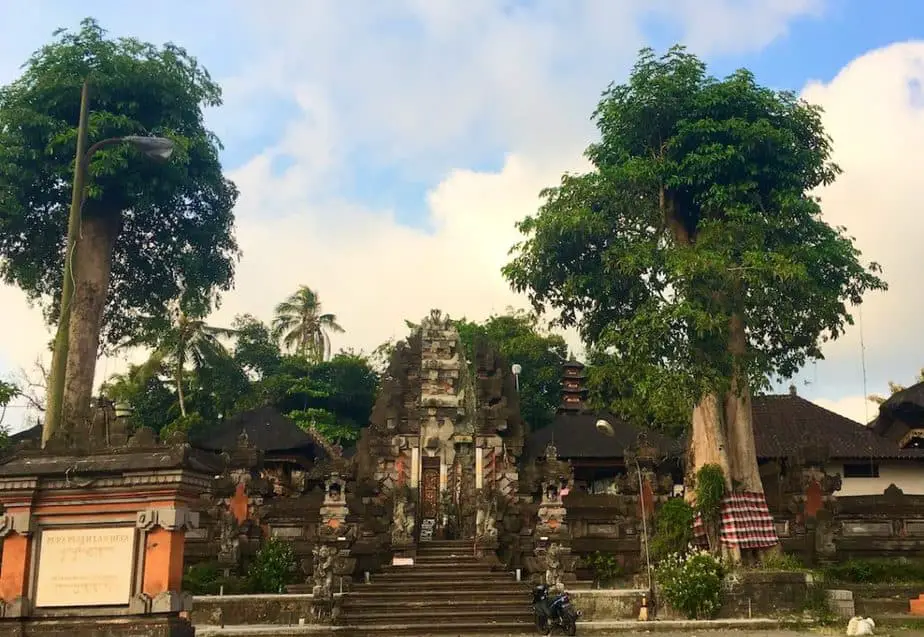
The second temple is usually found in the center of the village and is called the Pura Desa (village temple). The god Brahma, (the Creator) is worshipped here. This is the place for community events and daily spiritual activities.
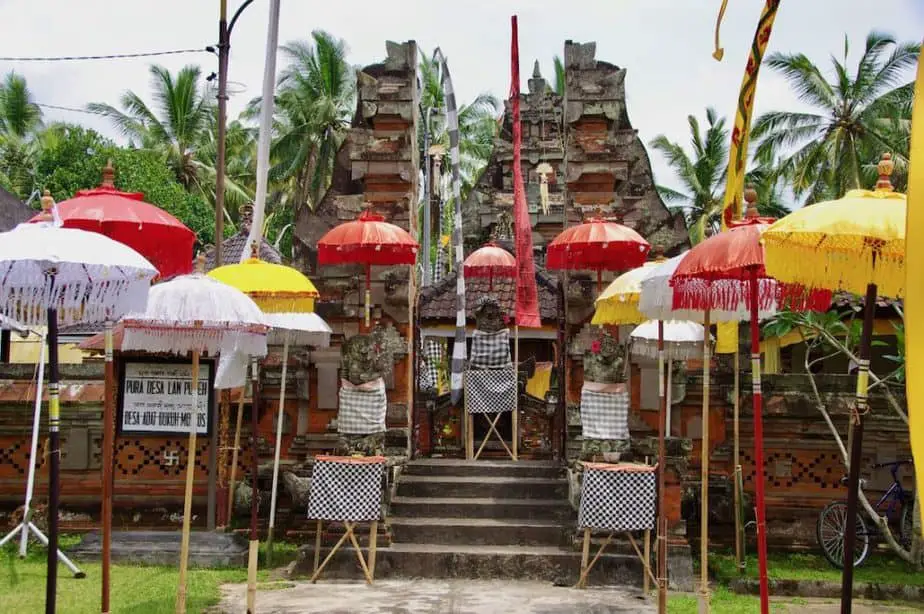
The Pura Dalem (temple of the dead) is the third temple located at the lowest point of the village facing the ocean or river, kelod. Kelod is the direction towards the ocean. After clear water flows down the mountains and through the land of humans it arrives dirty at the ocean. Kelod is considered unclean.
The temple of death is dedicated to Shiva (the Destroyer) or to the witch Rangda. There is a burial ground as well. The soul of the deceased will rest here until it is time to be completely purified by cremation.
These temples in Bali are known to have scary carvings and sculptures with bulging eyes and fangs. As a visitor, you will soon get a picture of how the Balinese presume the underworld and what awaits them if they don’t apply to what is expected.

The Occupational Temples In Bali
Balinese people with a particular livelihood or occupation also worship at certain temples. One of these occupational temples is the subak temple for farmers.
The subak temples are a network of shrines and temples dedicated to the Lake Goddess who resides at Lake Batur. She is also called the Rice Goddess or the Earth Mother.
Her temple sits on the rim of the Mount Batur caldera and is called Pura Ulun Danu Batur. This is the second most important temple in Bali.

There are also temples where merchants can pray and place offerings. One of them is in the shade of a big tree at the Ubud market.
The Ancestral Temples in Bali
Family members or descendants of a particular leader are worshiped in ancestral temples or family temples in Bali. These are private temples and travelers can not visit them.
However, there is one well-known royal temple in Mengwi that can be considered an ancestral temple and you can have a look.
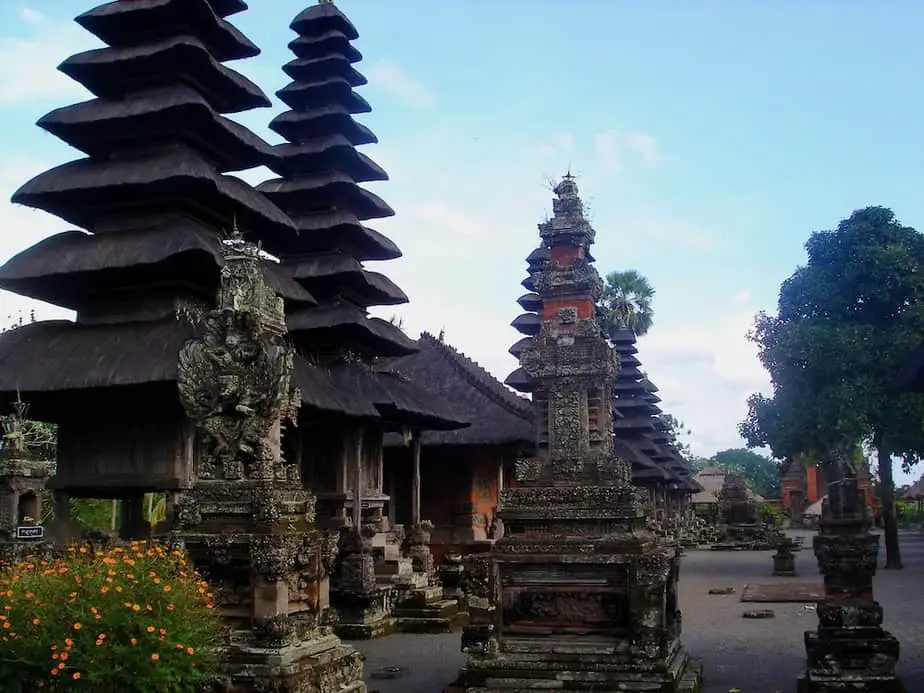
This royal temple, Pura Taman Ayun, was built as a main temple of worship for the people of Mengwi. They are able to worship at this temple instead of traveling far to other temples such as Besakih Temple, Luhur Batukaru Temple, or Ulun Danu Batur Temple.
Today Pura Taman Ayun has shrines dedicated to their noble ancestors, the previous rulers of the Mengwi royal family.
The Nine Directional Temples in Bali
While many ‘smaller’ temples have their unique character, the most spectacular are the 9 state temples, also known as Directional Temples (kahyangan jagat).
This type of temple is not owned by one village but belongs to every Balinese on the island. They are the holiest places to worship in Bali and are of great importance.
Directional temples protect the island and its people from evil spirits and are built at strategic locations all over Bali. The locations of these temples are usually stunning, which makes these temples very popular destinations for travelers.
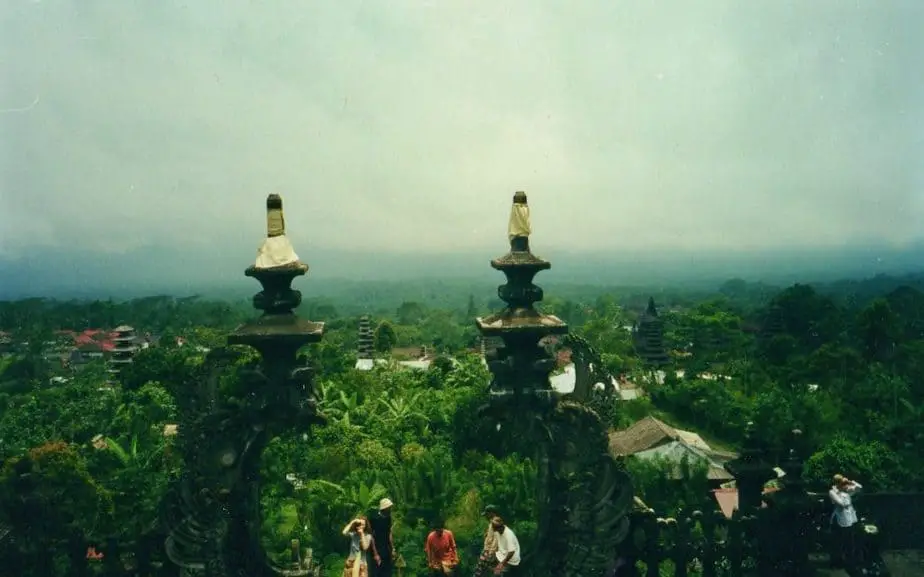
The Besakih Temple, the Mother Temple of Bali is the most important of all. It is located on the slopes of Mount Agung. This holy mountain is known as the ‘Navel of the World’ where all gods and goddesses reside.
The nine directional temples in Bali are:
- Pura Besakih, northeast
- Pura Lempuyang, east
- Pura Goa Lawah, southeast
- Pura Andakasa, south
- Pura Uluwatu, southwest
- Pura Batukaru, west
- Pura Pucakmangu, northwest
- Pura Batur, north
- Pura Pusering Jagat, center
Not all of the directional temples are known among travelers. This is mainly because some are not located in popular areas or are not as ‘impressive’ as others on the list.
The Sea Temples In Bali
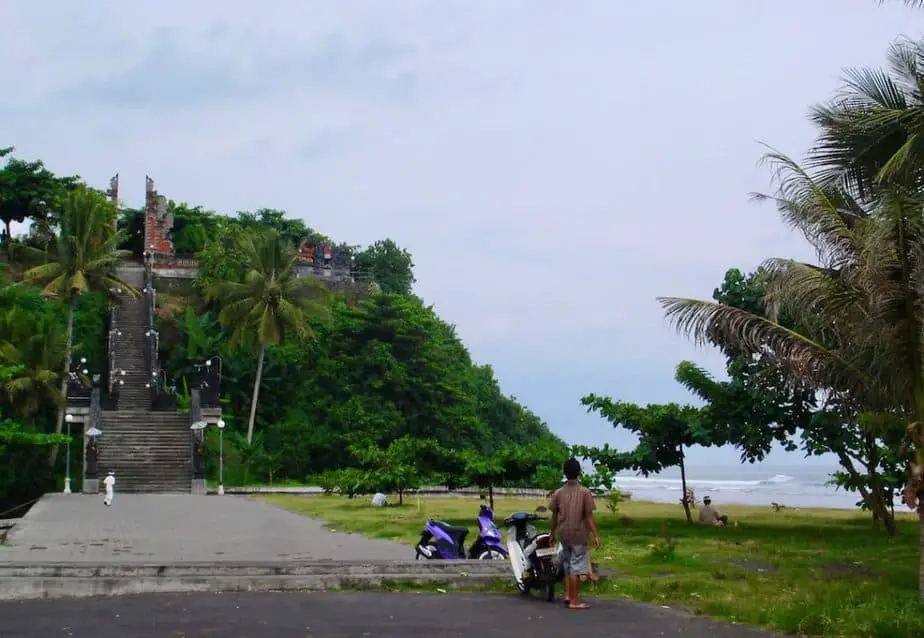
The sea temples are a string of temples built in the 16th century by a Javanese Hindu priest named Dang Hyang Nirartha. He appointed various areas in Bali to be holy and built temples to honor the sea gods.
The temples are linked like a chain and in the past one could see the next temple in the distance from the other temple. This row of temples around Bali is considered as spiritual protection.
The sea temples are:
- Pura Pulaki near Pemuteran
- Pura Gede Perancak, southwest of Bali
- Pura Rambut Siwi, near Balian beach
- Pura Tanah Lot, near Canggu
- Pura Luhur Uluwatu, southwest of the Bukit Peninsula
- Pura Mas Suka, the southern tip of the Bukit Peninsula
- Pura Sekenan on Serangan island near Sanur
Lay-out of the Temples in Bali
Temples in Bali do not always look alike. Some are only accessible at low tide such as Tanah Lot. For others such as Pura Lempuyang, you have to climb many stairs to the top.
But in general, all of the temples have the same layout.
A Balinese temple complex is divided into three courtyards. Like almost anything in Bali, the courtyards have three cosmological levels: the human world (kelod), the realm of the gods and deities, and the divine level (keja).

Outer Courtyard
To enter a temple you need to go through the outer courtyard which is called Jaba. It’s considered the transitional part between the outside world and the sacred area. All kinds of activities take place here, such as cockfights or non-sacred dances performed for visitors.
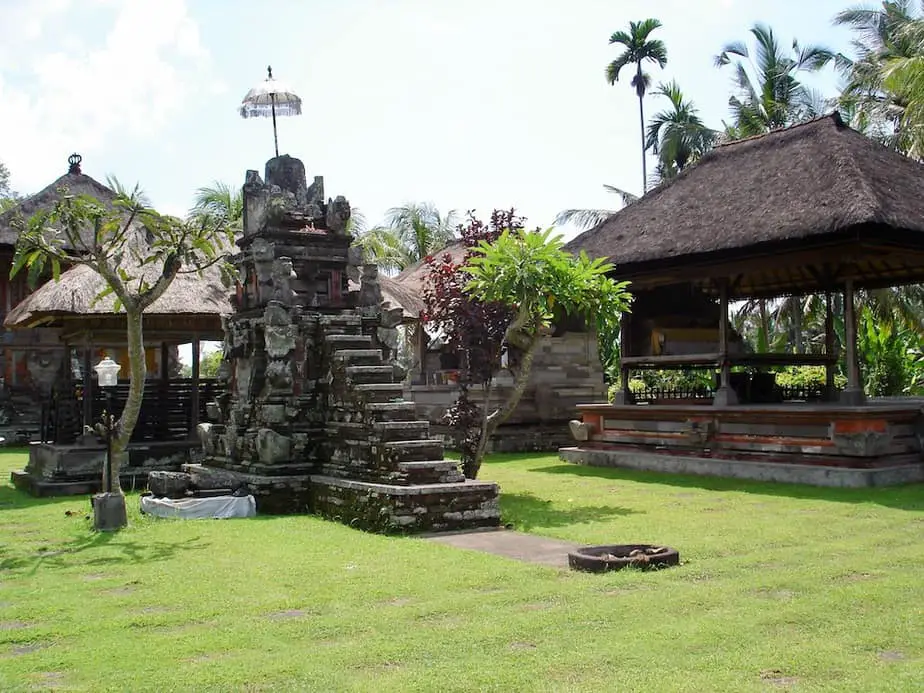
Middle Courtyard
Then you have the middle courtyard, Jaba Tengah. There are pavilions here where the Balinese can prepare their offerings or where meetings are held for priests. Gamelan music instruments and other temple relics are stored here too.
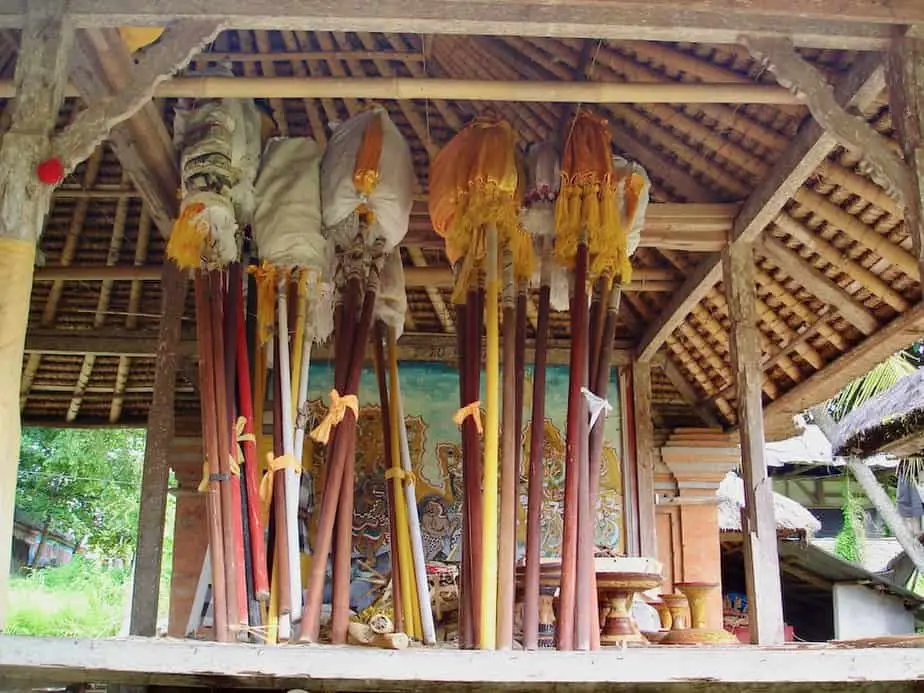
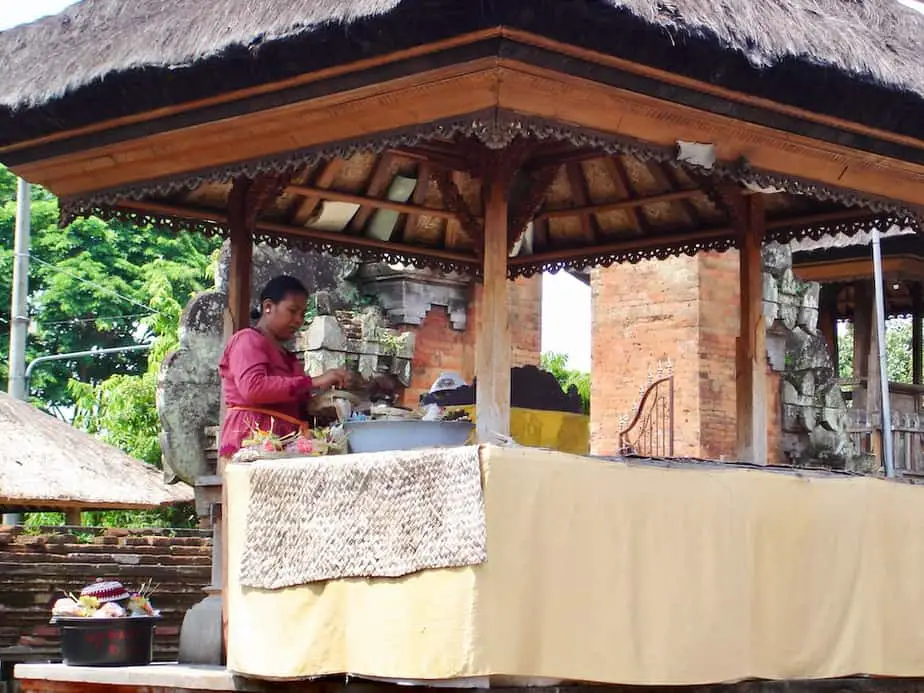
Inner Courtyard
The inner courtyard is at the back of the temple complex. This courtyard is called the Jeroan. This courtyard is considered the holiest part of the temple and is not accessible to visitors.
The shrines for the gods are found in the inner courtyard. Prayers are conducted in front of these shrines. This is also the area where offerings and temple rituals take place just as performances or sacred dances.
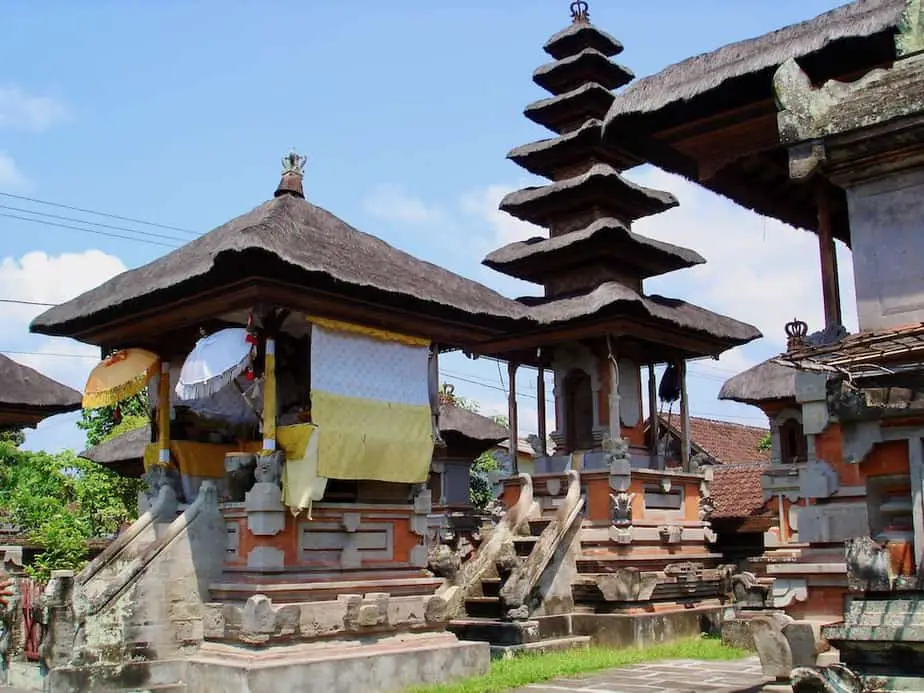

Temple Gates
The three courtyards are separated by beautifully carved gates. In the 2 outer courtyards, there are two main temple gates called the Candi Bentar.
If you look at the gate closely you can see that it looks like it has been split right in the middle. The carvings on both parts are identical and the inner walls are smooth to emphasize the separation.
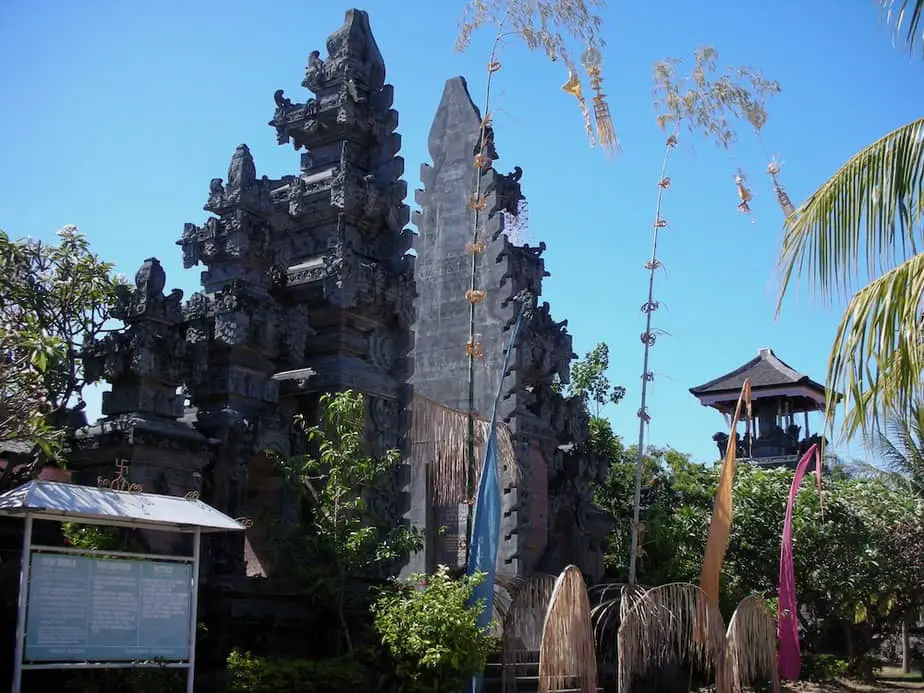
The gate to the inner courtyard is called the Kori Agung. Unlike the previous two, this gate is decorated differently and has a door.
Above the entrance of the Kori Agung there is the face of Bhoma, the Balinese Jungle God. This fierce-looking god might look like a bad guy but he is actually a protector. He is there to scare away the evil spirits from entering the holiest part of the temple.
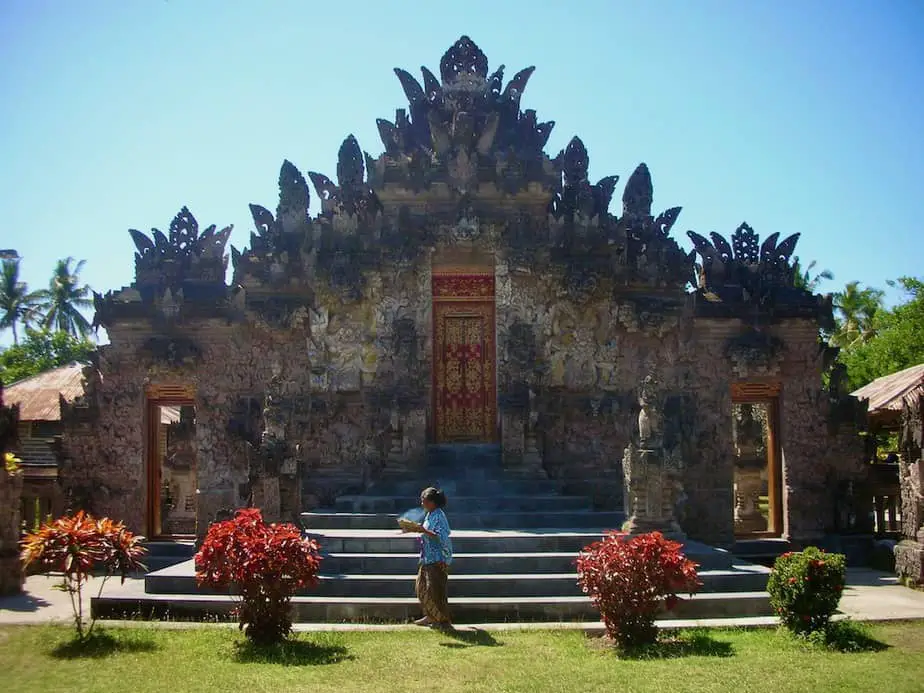
The temple gates of temples in Bali are often decorated differently. It depends on the time built and its location. The Mengwi and Buleleng styles are known as architectural highlights with their beautiful decorations.
Towers and Shrines
The towers and shrines within the courtyards come in all sizes and forms.
The Kul-Kul tower is easy to recognize as it has a large wooden drum hanging in the top. This tower is used for various reasons. Different rhythms are used to pass on a message such as gathering, a fire, etc.
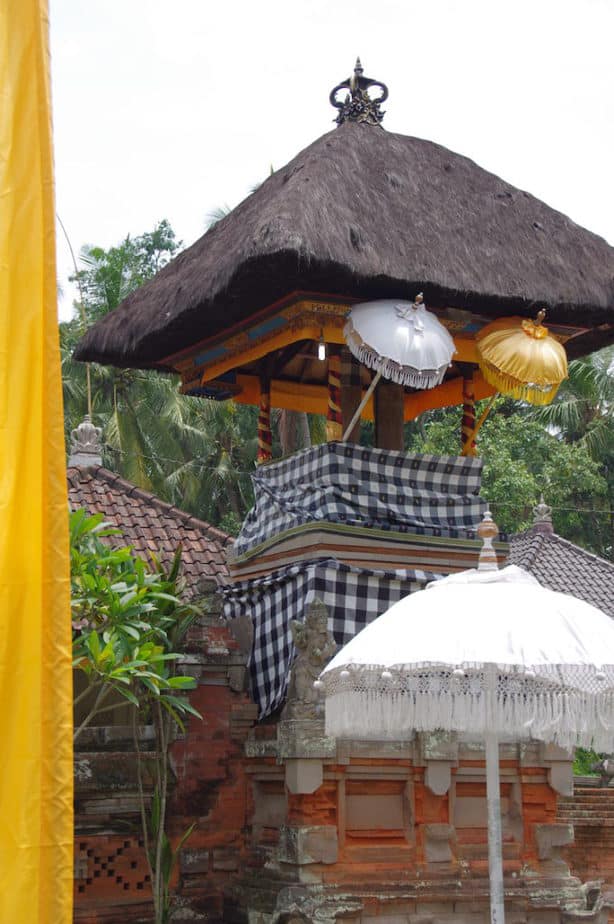
The shrines are made for different reasons. The most common shrine is to provide a home for the deity (palinggih) also known as a ‘seat shrine’. This shrine is also found in house temples and village temples.
The doors of this shrine are only open on religious occasions. The head of the shrine is the most sacred and is made of the black fiber of the sugar palm.

The same material is also used for the meru (pagoda-like structure) which can be found in the inner courtyard as well. These are the shrines dedicated to the higher deities. The height of a meru depends on the status of the deity.
Naturally, deities with high status will get a high meru. A meru always has an odd number of roofs but doesn’t exceed 11 because that’s the most sacred.
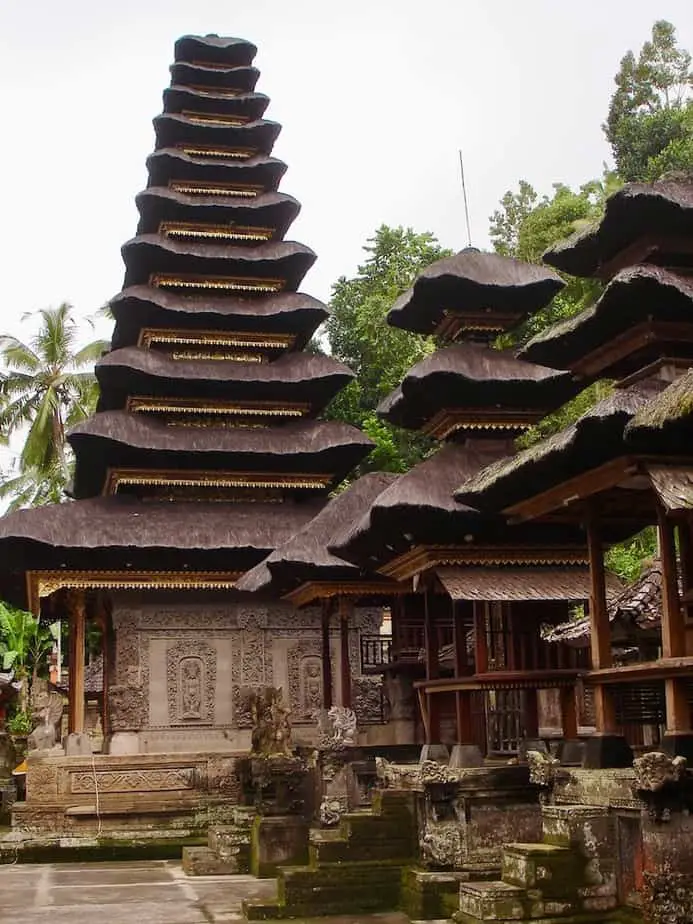
Who Builds The Temples In Bali?
With thousands of shrines and temples on the island, you wonder how they are able to build all of them. Is there a blueprint that everybody follows or is there a famous architect that you can hire?
Building a temple in Bali is not considered an art form but it’s part of the unique culture. The same counts for painting, wood carving, or Balinese dancing.
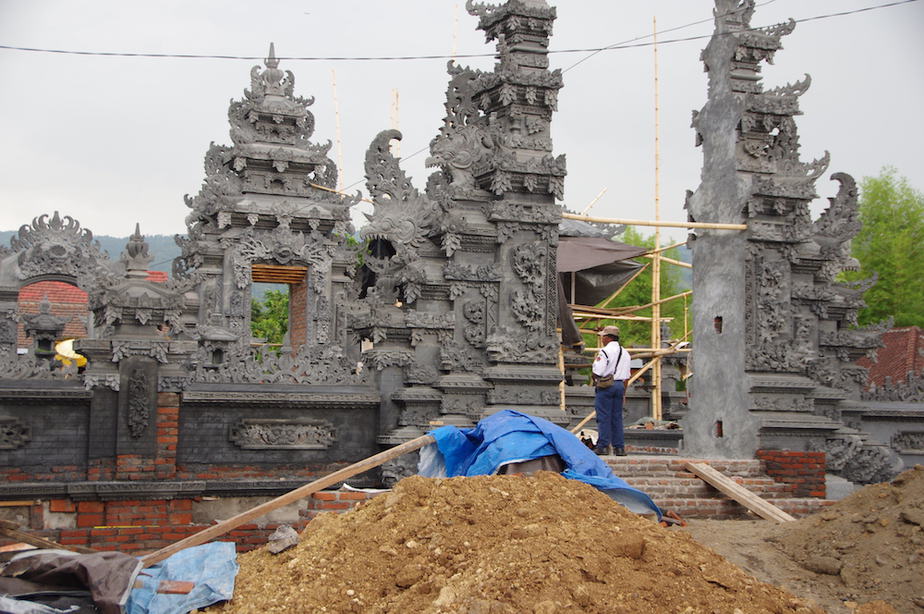
The knowledge of building a temple is passed on through generations and you can’t go to any school to learn how it is done.
To build a temple in Bali you will need the master sculptor. He knows how to build a temple in detail from the heart and doesn’t always use a plan. He often uses his own body for dimensions of the temple which means that every temple in Bali is unique.
The master sculptor always builds a temple which is symmetrical and in harmony with its environment. He will tell his team of builders where they should start and how to do it.
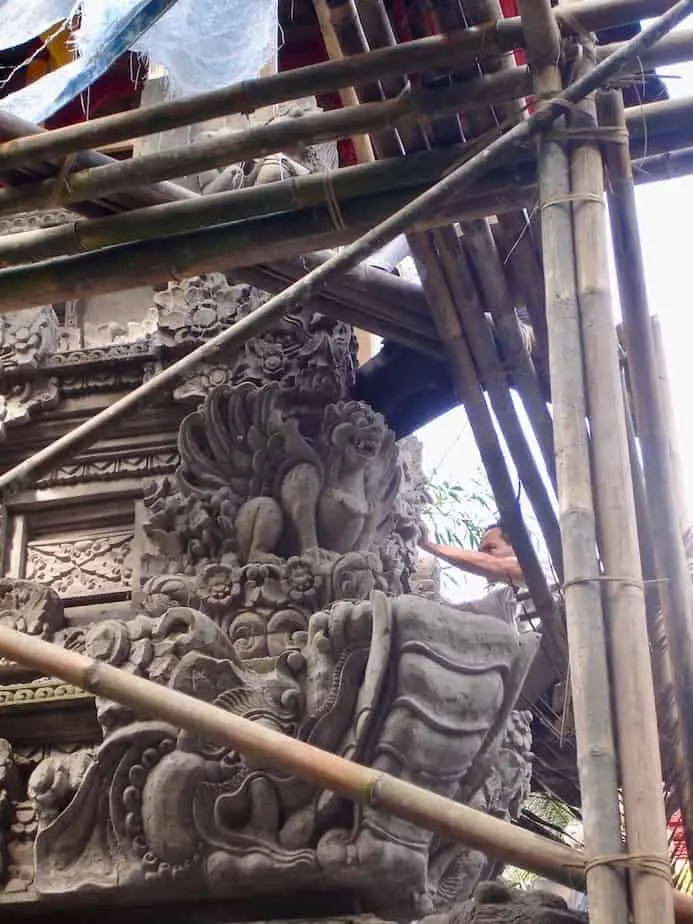
A disappearing craft
Traditionally they don’t use any mortar in the building of temples in Bali. The bricks and stones should hold each other and create their own strength. This is something you find often in religious buildings throughout the world. The Maya temples in Mexico or the pyramids in Egypt are a great example of this.
Like many things today, this form of building temples has slowly disappeared. The Balinese temples are now made using ferroconcrete.
Balinese temples are often made from grey volcanic sandstone called ‘batu candi’ (temple stone). It is very durable and has some amazing properties. It doesn’t get too hot or too cold, doesn’t scratch or stain easily. Due to the tropical climate, they have to renew a temple once in 50 years.
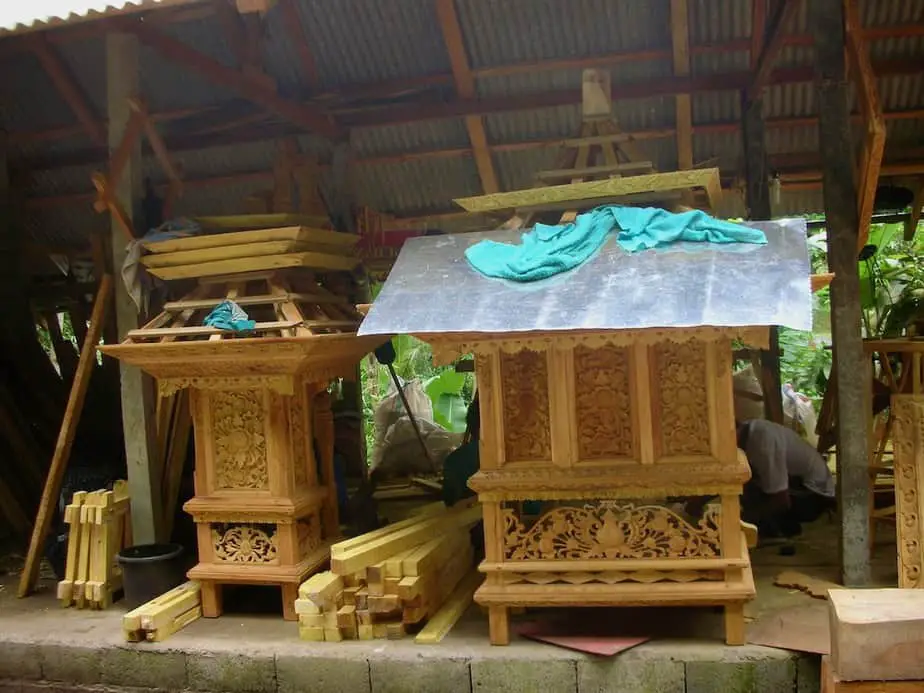
Festivals at the Temples in Bali
The Balinese have many ceremonies and festivals based on the 210 days Wuku Calendar. In one year it seems as if there is a ceremony going on almost every day.
Besides important holidays such as Galungan, Kuningan, and Nyepi the Balinese also celebrate the annual birthday of temples. This celebration is called Odalan. During this festival, the Balinese celebrate the day when the temple was built.
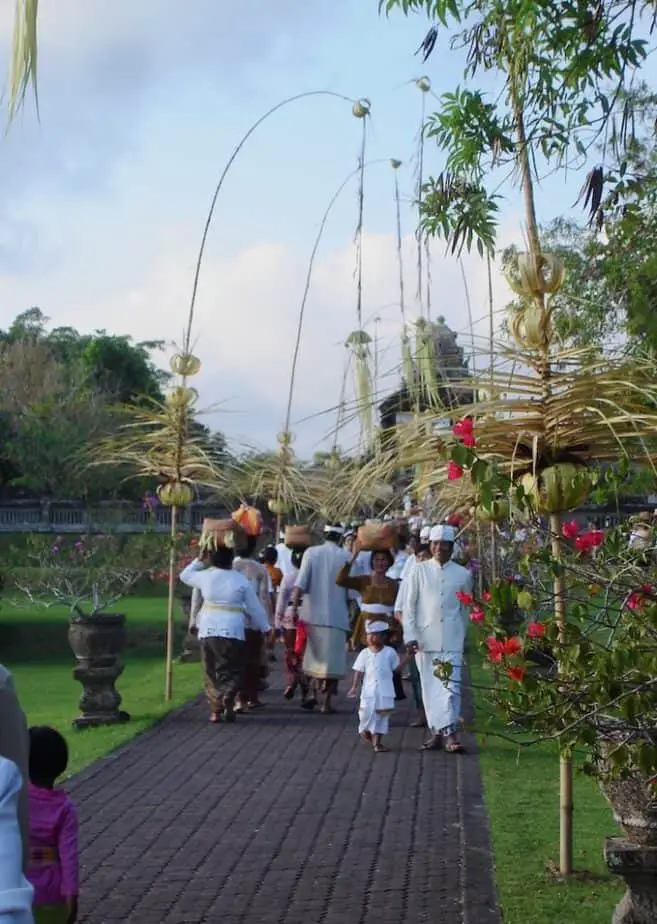
The Odalan is not celebrated for the big and most important temple. It is for every temple that exists in Bali. So now you understand why there is a religious ceremony going on in Bali every day of the year.
Some Odalan ceremonies take up to 1 to 3 days while there are those that can last for months. Besides religious ceremonies, the celebration includes Gamelan music, dance, comedy, and shadow puppet shows.
The celebration is also the moment when cultural knowledge is transferred to the next generation.
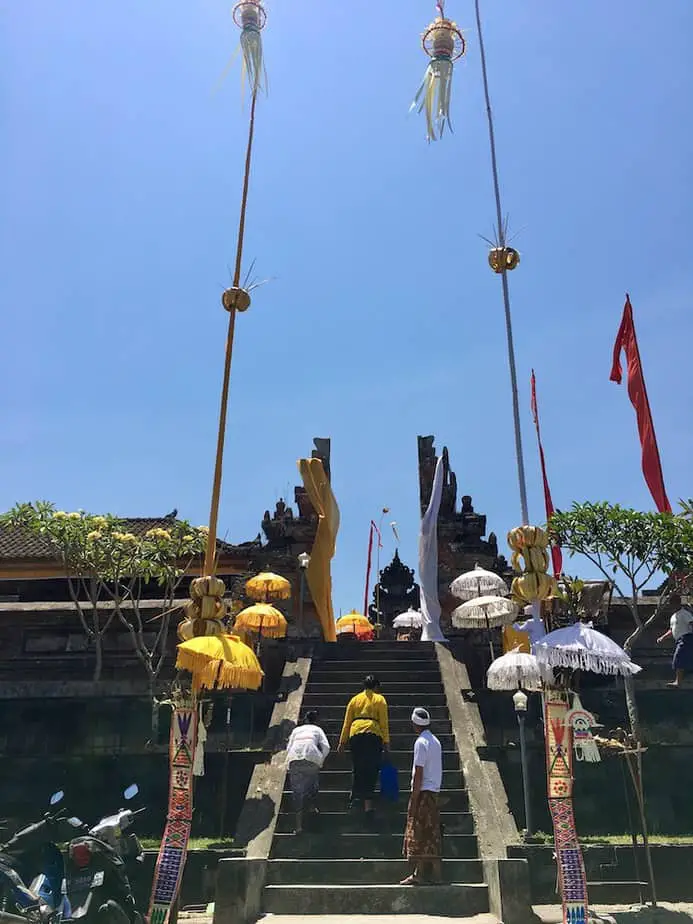
During the festive ceremony, gods descend from the mountains and take their seats in the shrines. The Balinese will bring offerings to welcome them.
Traditional Attire At The Temples in Bali

Even after visiting Bali so many times, it is always an incredible sight to suddenly bump into a Balinese crowd or procession heading to a temple.
They are beautifully dressed while carrying amazing offerings. You almost think it is staged, but it isn’t. It has been unchanged for generations, making it even more special today.
The Balinese consider the human body to represent the cosmos, therefore they must be well dressed to please the gods. The head is heaven while the feet are considered demon-like. The center of the body reflects humanity.
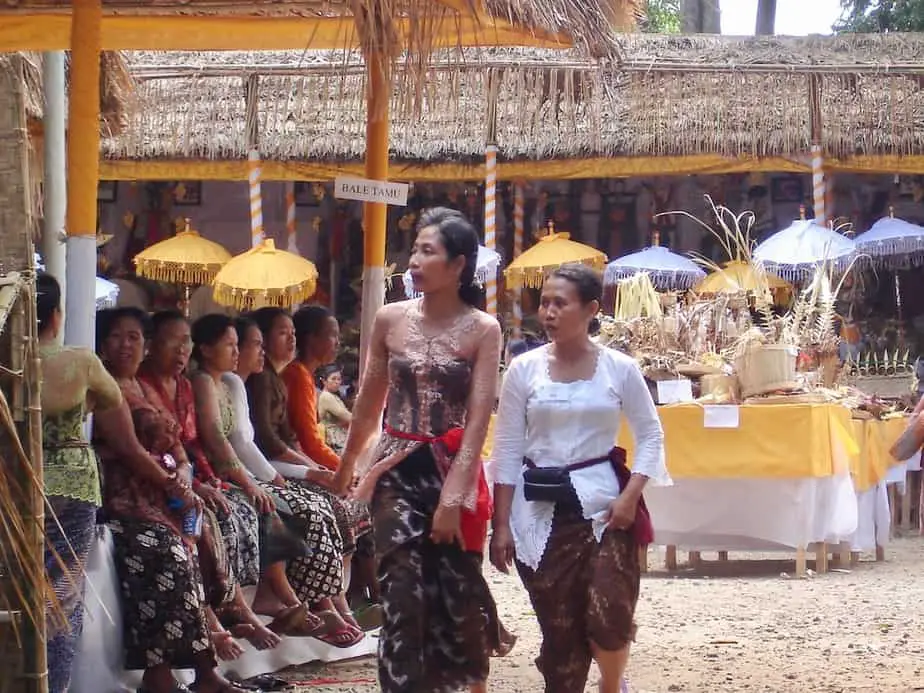
The Sarong (Kamben)
Everybody who visits a temple complex must wear a kamben, also called a sarong. This is a long cloth wrapped around the waist reaching the ankles.
The design and the quality of the kamben can differ. Javanese batik is the favorite and most used.
Black and white clothes are also very common. Often statues are wrapped with it too. This cloth represents the positive and the negative.
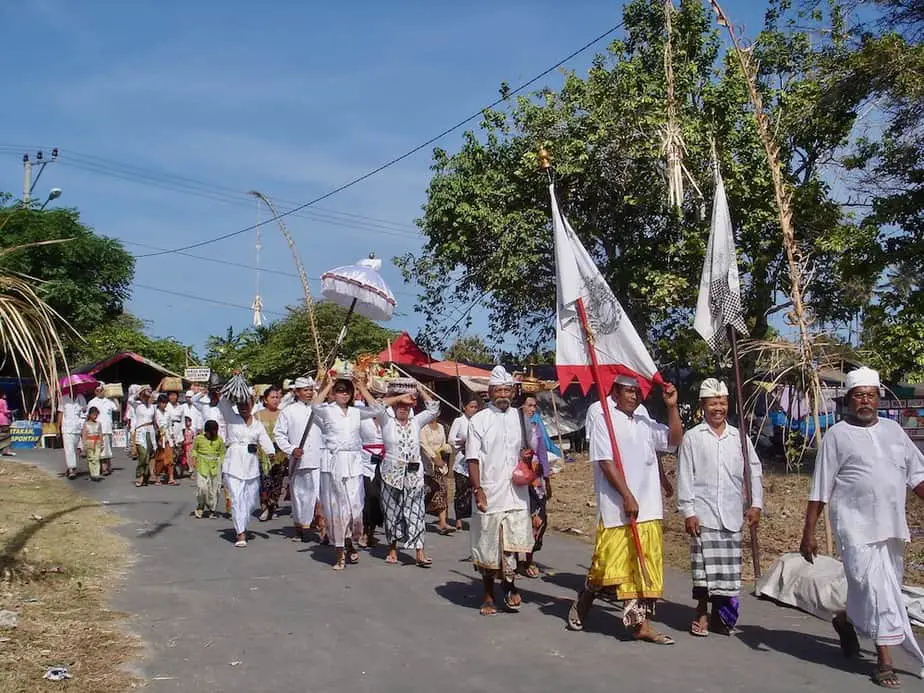
But most sacred are the ones that are woven and hold a mystical relevance. The dyeing process can take months to even years. There is a magical cloth called the geringsing. It is said that it is dyed with blood but that’s probably just a folk tale.
Men wrap the kamben around their waist and tie it with a long fold which falls between their legs. Then a second cloth called the saput is also wrapped around their legs but is much shorter. This one falls on their knees.

Men usually wear a white shirt on top together with a headcloth called a udeng. It is considered the gateway to heaven. The men wrap it around their heads in many different ways.
Priests are similarly dressed but from head to toe in the color white. Their hair is tucked away in a headcloth.
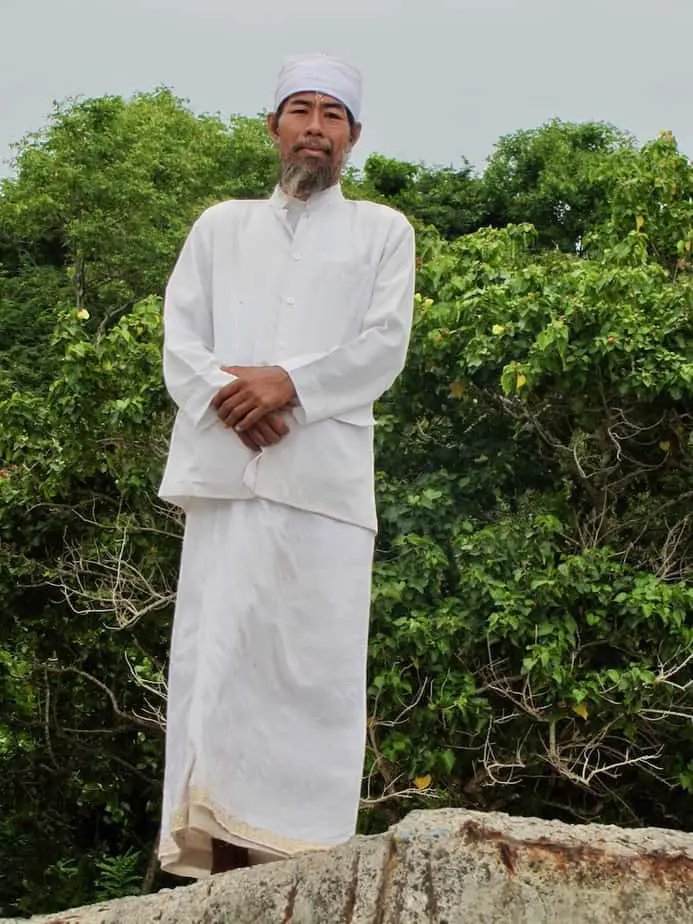
Women wear a kabaya, a long slim-fit top which is often laced. During religious ceremonies the kabaya is white. Other colors and designs are used during various gatherings creating the opportunity for women to add some personal touch. Unified colored kabaya is often used for village festivals.
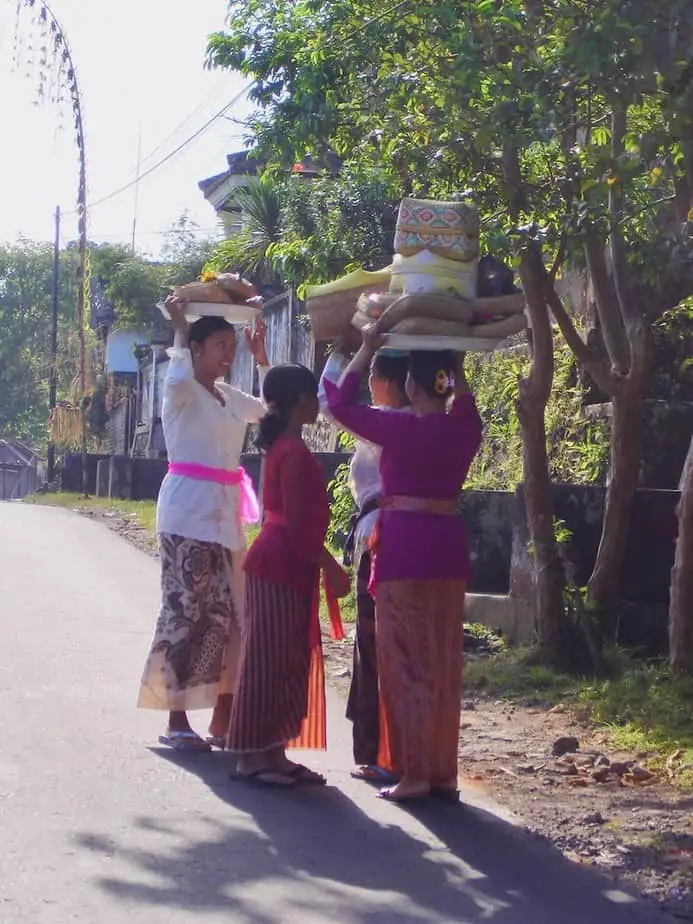
Waist Sash (Anteng)
The final piece of the Balinese attire is the anteng, also called selendang. The waist sash is a symbolic representation of tying off the upper world with the lower world. People entering the temple will be able to control their emotions and will only have clear and pure thoughts.
The anteng is mandatory for both men and women when entering a temple. Men tie the knot on the right side while the women on their left side.
What to wear when visiting the temples in Bali?
Like any religious sight, keeping to the rules of etiquette is highly appreciated. Before entering a temple in Bali you will find signs indicating what is and isn’t allowed.
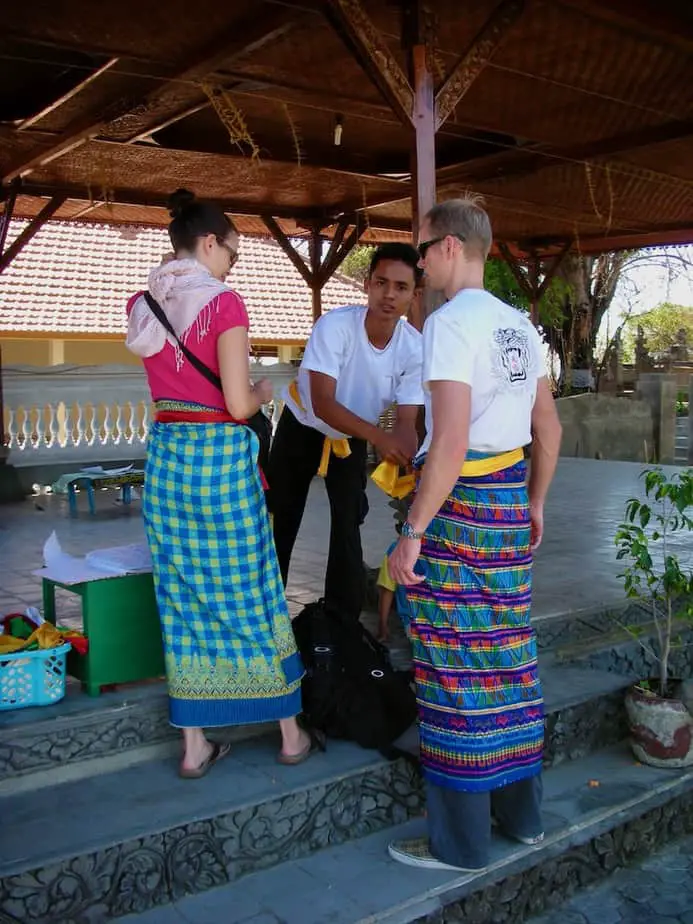
We have seen various signs. Some more elaborate than others.
At most temples you will see the following rules:
- Dress appropriately, knees, and shoulders covered. Preferably wear a sarong and a sash is mandatory. Those with long trousers should be able to enter the temple with a sash only.
- Women are not permitted to enter the temple during their menstrual period. This is also for women who have given birth in the last 6 weeks. People with open cuts and wounds should also not enter the temple complex. This is to prevent blood on the holy grounds. If this happens the whole temple must be purified.

Other important etiquettes that are usually not mentioned on the signs when entering are:
- Do not stand higher than the priest (Manku)
- Never point your feet towards shrines or holy objects. Men always sit cross-legged and women on their knees when praying.
- Don’t use flash
- Don’t stand before people who are praying and like any other place of worship, don’t make much noise.
- Make sure you don’t step on offerings.
- Small children who have lost their first tooth are not allowed to enter as well.
- Widows in mourning are not allowed to enter.
- Don’t use any drones
We were aware of the temple etiquette, but we only discovered the last three points on our visit to the Pura Luhur Batukaru.
Today many temples also have a sign with a ‘no drone zone’.

How to get to the temples in Bali?
It’s best to hire a driver for the day. A full-day tour to the temples around the island costs around 50/60 USD. It depends where you are staying though. When you stay in Ubud some are easily accessible by scooter too but this depends on your level of driving.
You can also check apps such as Gojek or Grab to see if drivers are available. This is very flexible and doesn’t cost much either. This is an ideal option when you only need to travel over a short distance to a temple.
Public transport is not really worth it because it takes too long. Busses or bemos (mini-buses) stop regularly. Often you have to change busses too and with the tropical sun in your neck, it’s just not worth it.
Which temple should you visit when you’re in Bali?
With so many temples in Bali, it’s hard to make a choice which one you should see. We have made a list of 14 Balinese temples to visit which are very special because of its location or atmosphere:
Besakih Temple
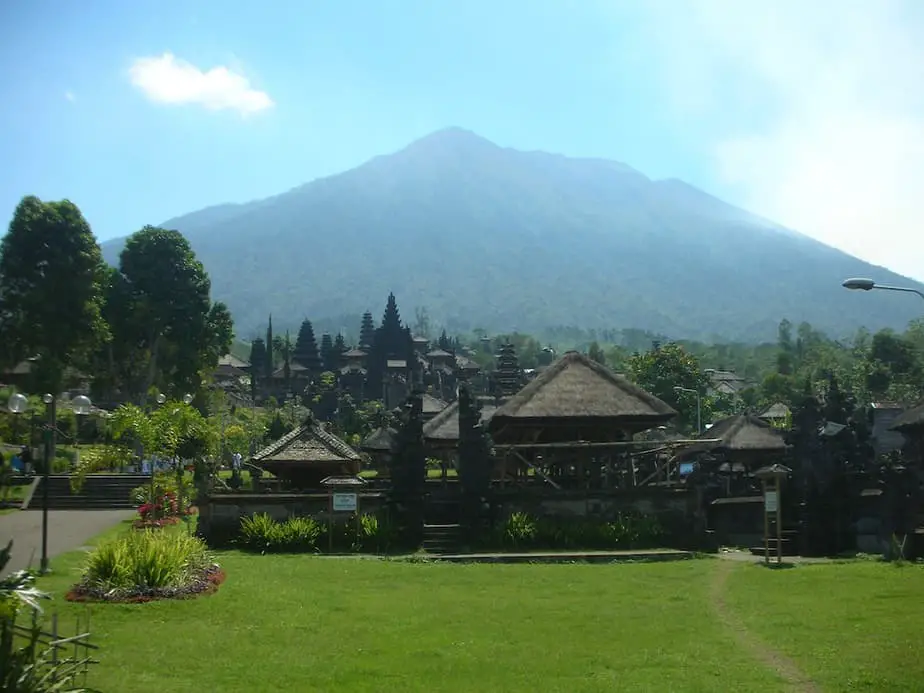
Pura Besakih is the most important and holiest temple for the Balinese people. The mother temple lies on the slope of the mighty Gunung Agung, the volcano where the gods live.
This temple is also the largest on the island. Besakih has 23 public temples built on terraces containing 298 sacred buildings. Additionally, there are 18 clan temples known as Warga that belong to powerful families.
The main sanctuary is the Pura Penataran Agung which is located at the highest point. You can only reach this after climbing many stairs. There are temples dedicated to Brahma the Creator, Shiva the Destroyer, Vishnu the Preserver.
The history of Pura Besakih
Even before the Majapahit settled in Bali around 1284, Besakih was of great importance. There have been stone-like shrines found on the place where Pura Penataran Agung now stands. It is said that these stones are more than 2000 years old.
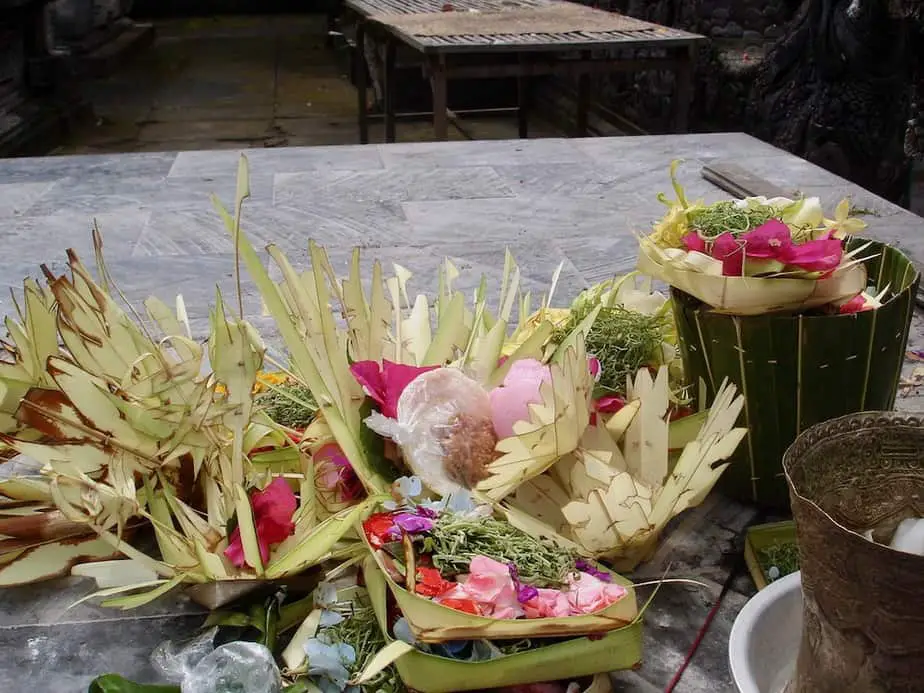
In the 14th century, Besakih became the state temple for the Gelgel kingdom. This changed in the 17th century when the kingdom was divided into smaller ones.
However, due to conflicts, the temple was neglected. Then in 1917, a huge earthquake damaged most of the temple. The Balinese saw this as a punishment for abandoning the temple. So in 1918, they started its restoration.
However again Pura Besakih was under threat in 1963 during a series of eruptions of Mount Agung. The eruption killed 1700 people but miraculously the lava flow missed Besakih with just a few meters. The Balinese understood this as a sign of the gods. The gods demonstrated their power but did not damage the temple the Balinese had dedicated to them.
Over the years Pura Besakih has been restored again in 1967, 1975, and 1999. Only a few parts that were saved in 1917 are still present.
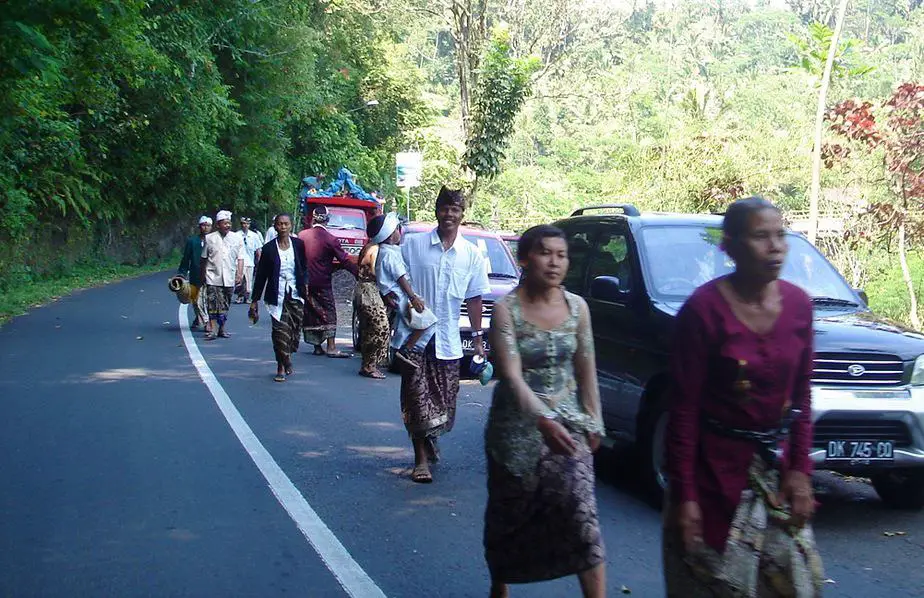
When to go
If you wish to see the mesmerizing scene of the beautifully dressed Balinese carrying and placing offerings then you are usually in luck at Pura Besakih. There are many celebrations and festivals held here. Balinese people from all around the island come here to perform rituals on a daily basis.
The biggest festivals are only held a couple of times a year. During the Batara Turun Kabeh, the gods descend to the temples. It is held on the eve of the 10th lunar month. The next will be on the 28th of March 2021.
Another celebration is Odalan. This annual celebration is held every 210 days according to the Balinese calendar. The next Odalan temple celebration will be 28 August 2020, 26 March, and 22 October 2021, 20 May, and 16 December 2022.
- Winning point: The most important temple in Bali with numerous colorful ceremonies. The location on the slopes of the mighty and active volcano Gunung Agung is unique. The road to Besakih is definitely worth the drive.
- Tip: If you plan to visit Besakih Temple it is best to go with a guide you arranged with a tour. He can show you around and tell you all the insights of the temple, making the visit more interesting. Additionally, you will avoid a lot of hassle upon arrival. There are many so-called guides who would like to show you around too.
- Openings hours of Pura Besakih: 8 am to 5 pm.
- Entrance fee: The entrance fee is 60.000 for adults and 30.000 Rph for children but includes sarong rental and sash.
- Combine with: A visit to Pura Besakih can best be combined with a rice field walk through the rice fields in Sidemen. This is also the ideal place for having lunch when you’re on your way to Besakih Temple.
How to get to Pura Besakih?
From Sanur to the Besakih Temple is a 51,2 km drive – 78 minutes. From Seminyak to the Besakih Temple is 59,9 km and takes around 92 minutes. From Ubud to Besakih is a 49,1 km drive – 70 minutes.
Goa Gajah Elephant Temple

Goa Gaja is an 11th-century temple complex. This is one of the sites where archeologists still haven’t pinpointed its exact origins and purpose. The mixture of Hindu and Buddist relics indicated the beginnings of the unique religion that the Balinese still hold today. It is considered a meditation site.
When you pass the entrance a long staircase will lead you to the temple grounds. From here you have a beautiful view of the entire site.
The bathing pools
The bathing pools have 6 statues from where the water flows. Originally 7, these statues represent 7 holy Sapta Nadi. Just as the 7 sacred rivers that flow in India: Gangga, Sindhu, Saraswati, Yamuna, Godawari, Serayu, and the Narmada.
The pilgrims would wash at these pools before entering the cave for meditation. The impressive cave entrance presumably represents the huge mouth of the earth god Bhoma or the witch Rangda, or the mix of two.
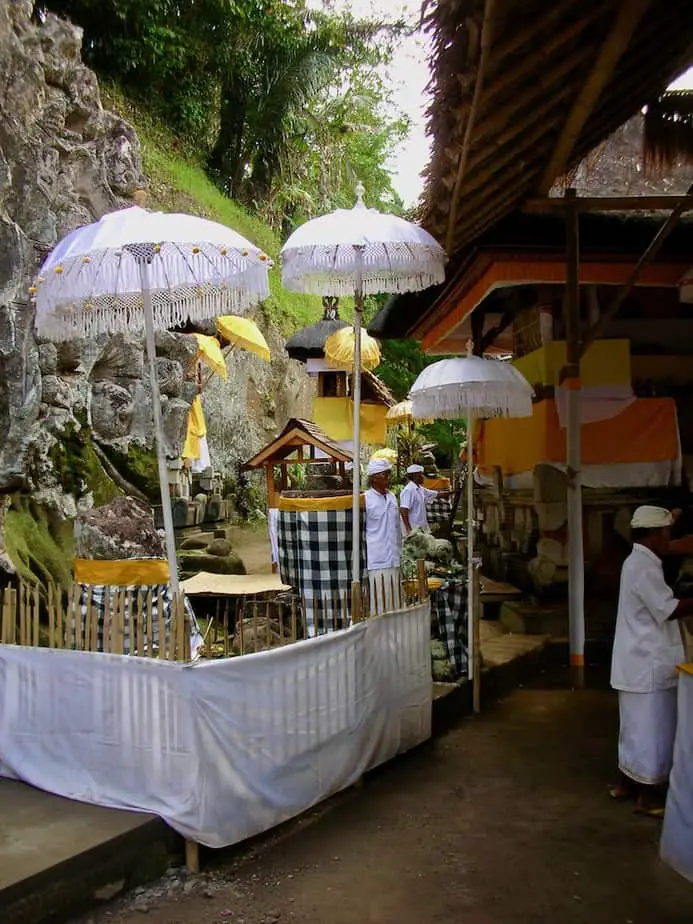
When the cave was discovered in 1923 by a Dutch colonial he interpreted the statue as an elephant. Goa Gajah means Elephant Cave and this is one of the theories where the site got its name from.
The statue fountains and pools were only discovered much later in 1945 and have been restored over the years.
- Winning point: Scenic spot with interesting characteristics from Buddhism and Hindu Dharma. Quiet when you arrive early in the morning. Easy to walk through the rice fields to the archaeological site of Yeh Puluh.
- Tip: You can easily walk through the rice fields to the archaeological site of Yeh Puluh.
- Entrance Fee: Rp. 60.000 for an adult, Rp. 30.000 for a child.
- Openings hours of the Goa Gajah Temple: 8 am to 4.30 pm
- Combine with: You can best combine this temple with any of the highlights in Ubud, the Tegenungang Waterfall, or with the Tirta Empul Temple.
How to get to Goa Gajah?
From Sanur, it’s 23,8 km and takes 35 minutes when the traffic is light. From Seminyak, the distance is 30,6 km – 53 minutes. Goa Gajah is just outside of Ubud on Jalan Raya Goa Gajah, Desa Bedulu. Travel time is 8 minutes only.
Goa Lawah Temple
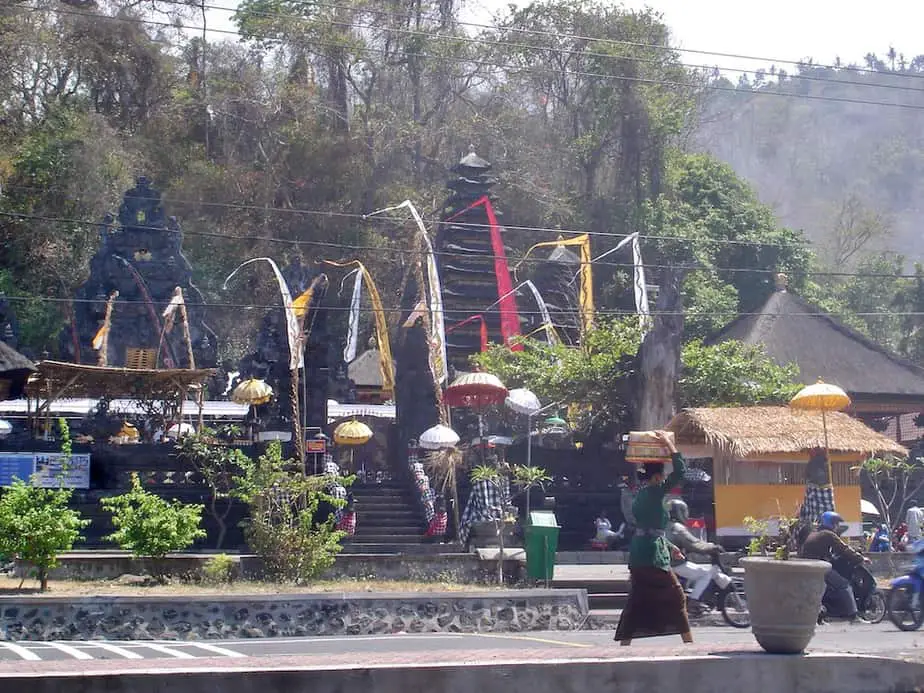
Pura Goa Lawah (translated: Bat Cave) is known for its fruit bats that inhabit the caves during the day. They are considered the guardians of the temple and are protected by the Balinese. You can see the bats hanging on the ceiling of the cave.
Besides the bats, the cave is also home to large rock pythons. The priests are happy to show them to you 😉
It is unknown how deep the cave is, as it prohibited to enter it too far. Some say it will lead you all the way to Besakih Temple while others claim it is an undersea tunnel to Peed Temple on Nusa Penida island.
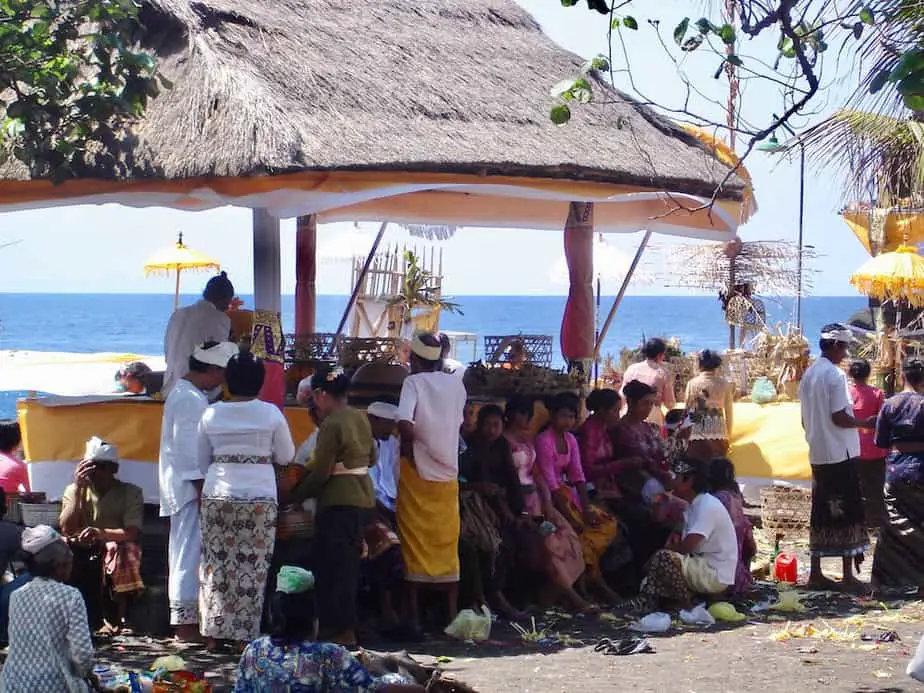
If there isn’t a ceremony going on at the temple you are likely to pass the temple. But when there’s a ceremony going on we’re sure you will stop and have a look.
A Directional Temple
While the Goa Lawah Temple might not look as stunning as the other temples, the temple is of great importance to the Balinese as it one of the nine directional temples.
This one is dedicated to the south-east. It was built in the 11th century by the Hindu priest Mpu Kuturan who introduced Hinduism on Bali.
- Winning point: Goa Lawah Temple has a very different atmosphere compared to other Balinese temples. This is because of the fruit bats and the many ceremonies that take place here. It’s a small temple and a good stop when passing through.
- Tip: Not only have a look at the temple but also the Balinese worshippers on the beach. It’s a colorful sight.
- Entrance Fee: Access to Pura Goa Lawah is for 25.000 Rph and 15.000 Rph for children. This doesn’t include the sash and the sarong.
- Openings hours of Gunung Kawi: 8 am to 6 pm.
- Combine with: The Goa Lawah temple visit is best combined with a visit to Bias Tugal Beach and Blue Lagoon Beach in Padangbai.
How to get to Goa Lawah Temple?
Goa Lawah is easily accessible on the main road from Klungkung (Semarapura) to Amlapura in the eastern part of Bali. The address is Jalan Raya Goa Lawah, Pesinggan. From Sanur to Goah Lawah is 34,4 km – 44 minutes. From Seminyak, the distance is 43,2 km – 61 minutes. From Ubud to Goa Lawah is 29,6 km – 44 minutes.
Gunung Kawi Temple in Tampaksiring
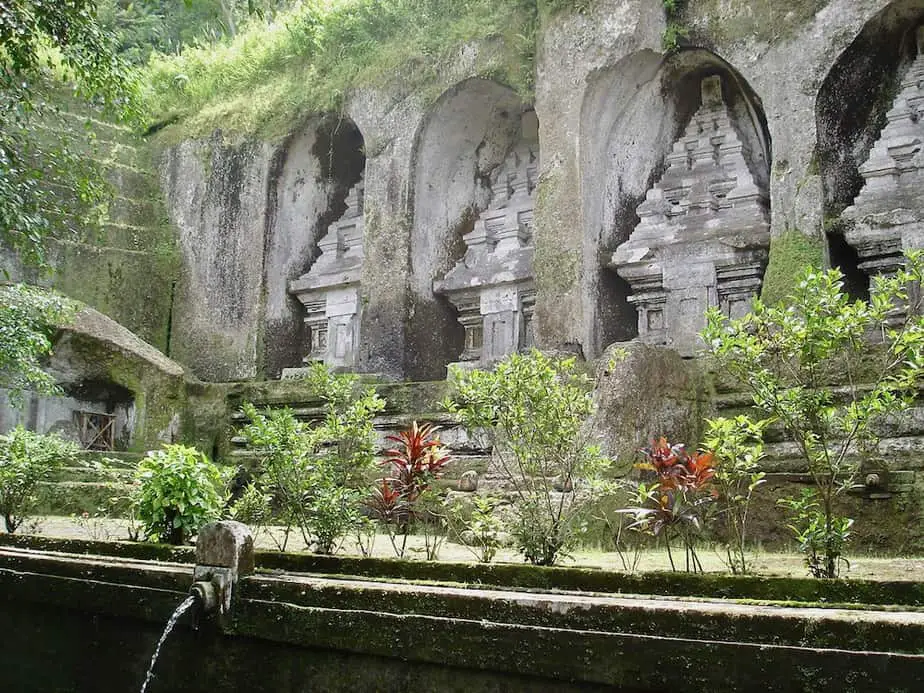
The Gunung Kawi Temple is one of our favorites when it comes to location. It is set in a lush valley surrounded by coconut trees and with the sacred Pakerisan River slowly running through it.
The road leads you past several souvenir shops until you descend 315 steps down into the Valley of the Kings. Here you’ll find huge ancient ‘tombs’ chiseled out of rocks. They are actually false doors to the other world according to the Balinese.
- Winning point: Gunung Kawi is both a Buddhist site and a Balinese Hindu Dharma temple. The location is fantastic and not that many tourists stop here to have a look. A hidden gem for sure.
- Tip: Walk in the rice paddies left from the five tombs and follow the path. This will lead you to a small waterfall.
- Entrance Fee: Once you arrive at the parking lot you can head over to the ticket counter and get access to the sight for 50.000 Rph. This includes the sash and the sarong to enter the temple area.
- Openings hours of Gunung Kawi: 8 am to 6 pm.
- Combine with: The Gunung Kawi visit is best combined with a visit to the Goa Gajah temple (8 minutes from Ubud) and the Tirta Empul temple (5 minutes north from Gunung Kawi).
How to get to Gunung Kawi?
From Sanur to Gunung Kawi in Tampaksiring is 38.5 km and takes around 55 minutes by car when the traffic is light.
From Ubud to Gunung Kawi is the easiest since it’s only 13.7 km and takes around 24 minutes. From Seminyak to Gunung Kawi is 44.2 km and takes around 63 minutes when the traffic is not too crazy.
Luhur Batukaru Temple
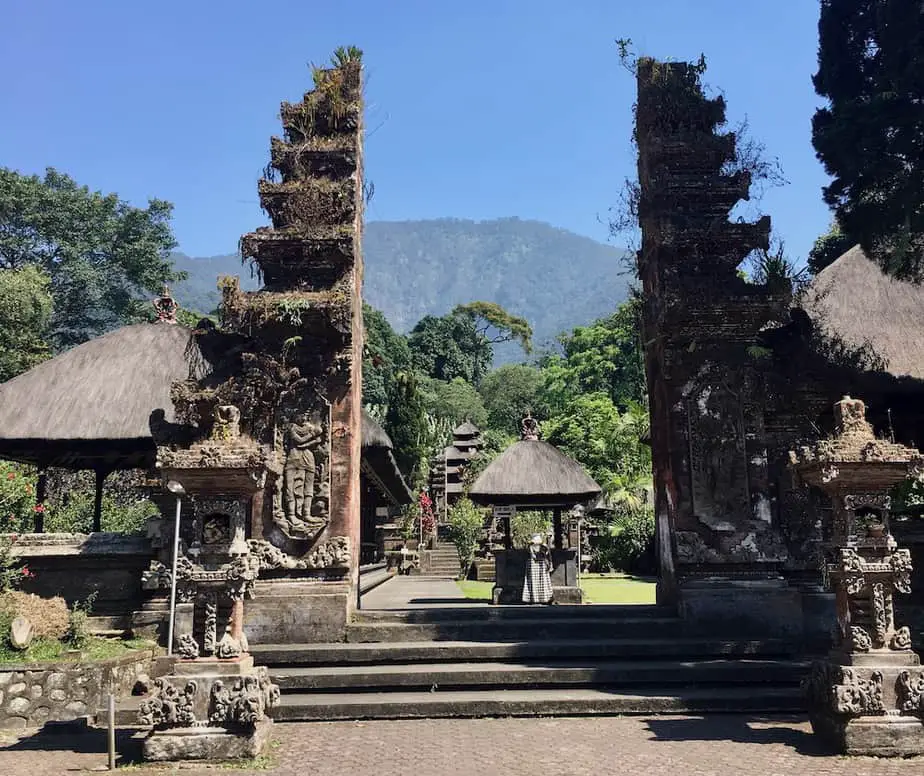
The Luhur Batukaru Temple can be found on the slopes of the extinct volcano Gunung Batukaru. On both sides and the northern side, it’s covered by mountain forest. This temple is also one of the nine directional temples and is the guardian of the west.
This unique temple is not visited a lot by foreign tourists which makes it an ideal spot for admiring the temple architecture. However, since Pura Luhur Batukaru is part of the nine directional temples many Balinese come here to pray and place offerings.
This temple is also a state temple to the kings of Tabanan and there are many shrines dedicated to their ancestral gods. The most important structure in the temple is the 7-meter high thatched pagoda. This is dedicated to the God of Batukaru Mountain called Mahadewa.
- Winning point: One of the best things about this temple is the location on the slopes of Mount Batukaru. You can hear the birds sing and there are hardly any tourists.
- Tip: East of the temple you will find a small pond dedicated to the gods of Lake Tamblingan. There’s a small shrine on the island which is only accessible by the priest.
- Entrance Fee: Ticket booth is on your right when you leave the parking lot. Access to the temple ground is 20.000 Rph and includes the sarong and sash.
- Openings hours of Pura Luhur Batukaru: 8 am to 6 pm but open 24 hours for those who come to worship.
- Combine with: The Luhur Batukaru Temple is best combined with a visit to the Yeh Panas hot springs at Penatahan, the ricefields of Batukaru and the ricefields of Jatiluwih.
How to get to Luhur Batukaru Temple?
From Sanur to the Pura Luhur Batukaru takes around 84 minutes with a total distance of 50.5 km. From Ubud, it’s 68 minutes – 37.3km. For those travelers coming from the Seminyak area, it’s 70 minutes over a distance of 45,4km.
Pura Luhur Uluwatu
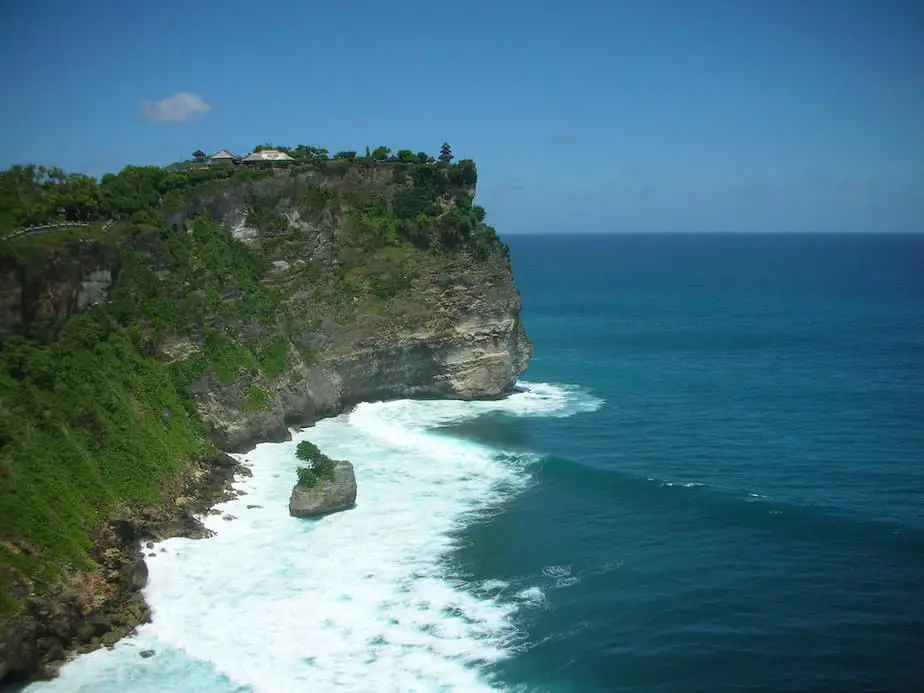
The Luhur Uluwatu Temple is located around the corner of one of the best surf waves in Southeast Asia, Uluwatu. This small Balinese temple is perched on a 200m high cliff above the Indian Ocean.
The temple is one of the nine directional temples, the guardian of the southwest. This means it’s open to every Balinese and especially during Balinese festivals it can get even busier than it already is.
It is said that the temple was built by the famous Javanese priest Mpu Kuturan in the 11th century.
Another famous Javanese priest, Dang Hyang Niratha, also came to this temple in the 16th century and build several shrines. The Balinese also believe that he found enlightenment at the tip of the temple. The three-tiered pagoda on the tip is dedicated to him.
- Winning point: When you walk along the edge of the cliff you will have a perfect view of the temple and the cliff below. You can hear the waves crash into the rocks.
- Tip: Don’t feed the grey-tailed macaques even though you can buy peanuts on the parking lot. They are cheeky and like to go for your sunglasses or water bottle.
- Entrance Fee: Access to the Luhur Uluwatu Temple is 30.000 Rph for adults and 15.000 Rph for kids and includes the sarong and sash. If you want to see a Kecak Fire Dance you can get tickets from 4.30 pm to 5 pm and the dance starts at 6 pm. Tickets cost 100.000 Rph per person.
- Openings hours: The Luhur Uluwatu opening hours are from 8 am to 6 pm.
- Combine with: This temple is best combined with one of the best surf beaches in the region such as Uluwatu Beach, Balangan Beach, Dreamland Beach, Padang Padang Beach, and Green Bowl Beach.
How to get to the Luhur Uluwatu Temple?
There is no public transport going to the temple so best is to hire a private driver or rent a scooter.
From Sanur, it takes around 60 minutes – 36,8 km. From Ubud, it’s 85 minutes – 53,3 km. From Seminyak to the Luhur Uluwatu Temple should take 37 minutes – 26,2 km but in reality, travel time can be doubled because of the traffic conditions.
Tanah Lot Temple
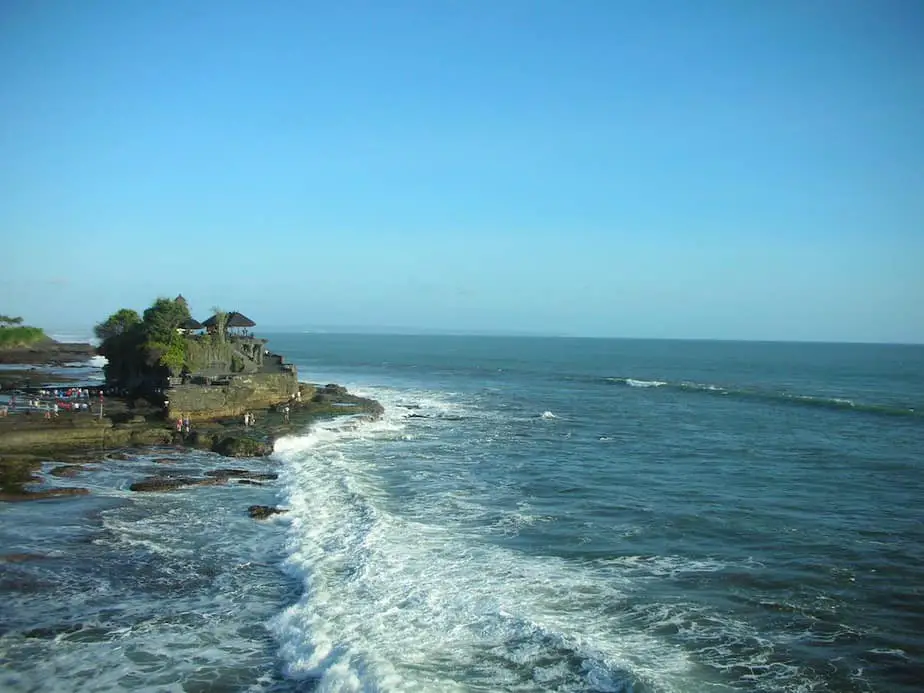
The Tanah Lot Temple is the most photographed temple in Bali. It’s located on a rock formation and only accessible during low-tide.
The temple was also built by the Javanese priest, Dang Hyang Nirartha in the 16th century. It is part of the chain of sea temples that protect Bali from evil spirits.
According to one legend he was drawn to the site by a light coming from a holy spring.
Fearing his popularity a local priest asked him to move on but Nirartha responded by going into meditation. He used his powers to force the rock he was sitting on out to sea and changed his scarf into several snakes which still guard the temple.
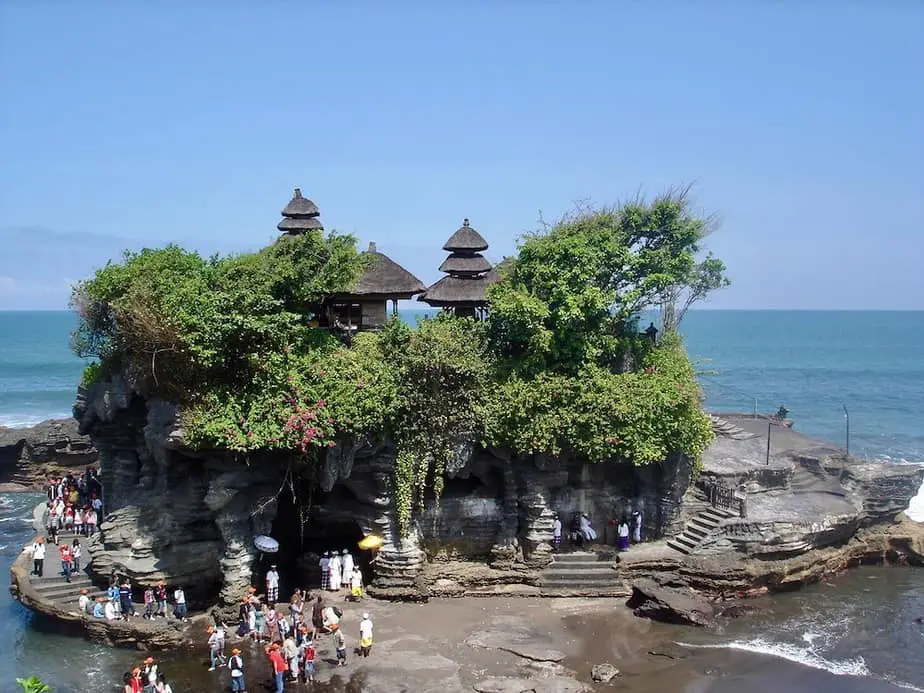
Nowadays only Balinese Hindu visitors can climb the stairway to the temple. The base of the rock has eroded over the years and has been rebuild with help from the Japanese government.
- Winning point: The Tanah Lot Temple is a unique and beautiful site with the waves rolling in on the black sand. It is one of the sunset temples in Bali.
- Tip: When standing on the beach in front of the Tanah Lot temple go to the right and follow the cliff path. From here you will have a spectacular view on the waves crashing into the base of the temple.
- Entrance fee: Access to the temple costs 60.000 Rph for adults and 30.000 Rph for kids. There is no need for a sarong and sash since you can’t get into the temple grounds.
- Opening hours: The opening hours of the Tanah Lot temple are from 7 am – 7 pm and best is to visit the temple in the early hours.
- Combine with: This temple is best combined with a visit to the Rambut Siwi Temple, Balian Beach, or the route to Mount Batukaru via Antosari village.
How to get to the Tanah Lot Temple?
Coming from Sanur it takes around 54 minutes, 27,1 km when the traffic is light. From Ubud to the Tanah Lot Temple is around 60 minutes – 33km. From Seminyak to the Tanah Lot Temple is around 33 minutes- 17,2km.
Rambut Siwi Temple
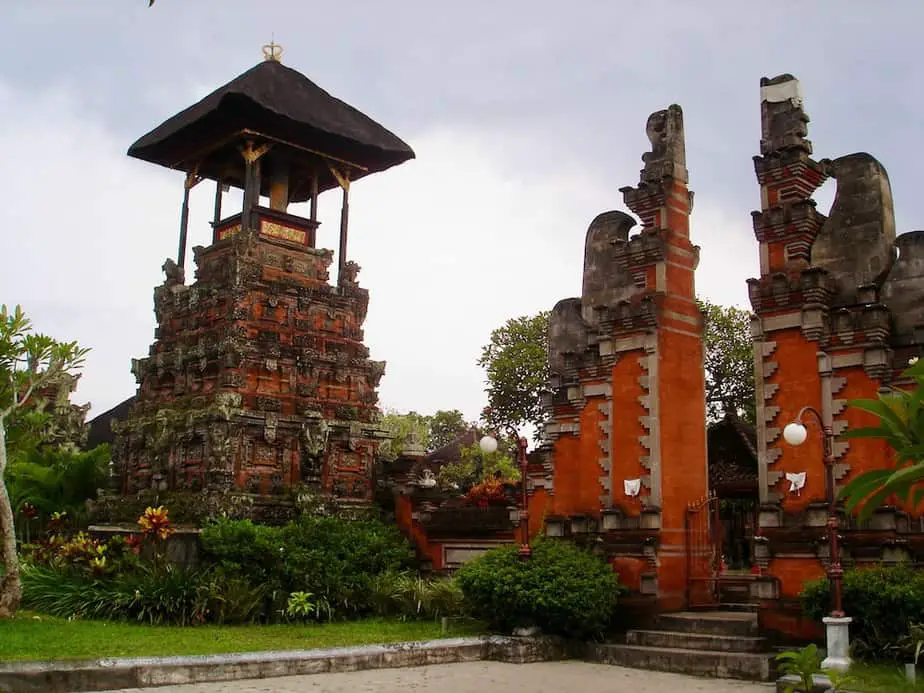
The red-bricked Rambut Siwi Temple is located in west Bali in the Jembrana district. For the Balinese this a very important temple. This is the place where the Javanese Hindu priest, Dang Nyang Niratha, stopped and decided this spot to be a sacred place.
He donated a lock of his hair (Rambut in Indonesian) and some of his clothing to the temple. This is now stored in a sandalwood box buried in the three-tiered pagoda in the inner courtyard.
- Winning point: The Pura Rambut Siwi is located on the beach and when standing in the temple you will have an amazing view of the Bali Strait. On clear days you can easily see Java island.
- Tip: Ask for the guardian of the temple to show you around. This way you will get the most of this temple and learn more about the area.
- Entrance fee: The entrance fee to the Rambut Siwi Temple is 20.000 Rph and includes a sarong and sash if you don’t have any. Not that many tourists visit the temple which is great.
- Opening hours: The opening hours to the Rambut Siwi Temple are from 8 am – 5 pm.
- Combine with: A visit to the temple is best combined with a visit to Taman Nasional Bali Barat, Bali’s only national park. You can go on a hiking trip or snorkel around Menjangan Island.
How to get to the Rambut Siwi Temple?
From Sanur to the Rambut Siwi Temple takes around 2 hours and 14 minutes – 84,1 km. From Ubud to the Rambut Siwi Temple is 1 hour 56 minutes – 79,7 km. From the Seminyak area, the drive is around 1 hour 50 minutes.
Taman Ayun Temple
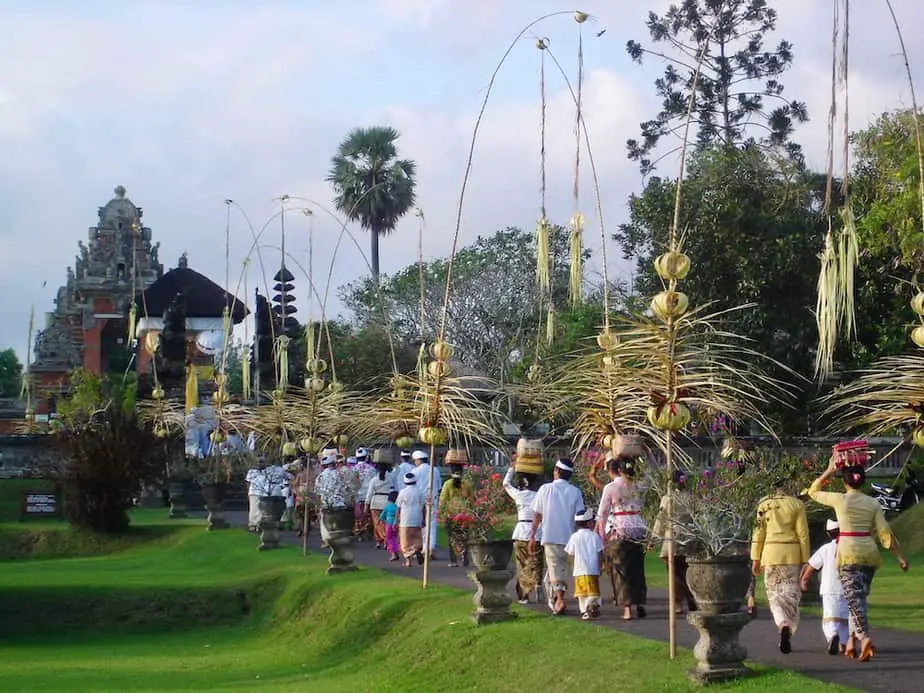
The royal public Taman Ayun Temple was built by the king I Gusti Agung Anom in 1634. This temple is encircled by a moat with lotus flowers. You can’t access the inner courtyard but there’s plenty to see when walking around.
The temple is home to several multi-tiered pagodas and is considered the second biggest temple after Besakih. Even though the royal family of Mengwi doesn’t have any power any more they still sponsor the temple. Many shrines are dedicated to their deified ancestors.
Especially during a festival, the Taman Ayun (beautiful garden) Temple is a special place to be. You can see loads of Balinese balancing baskets with offerings on top of their heads.
- Winning point: This temple is well maintained and spotlessly clean. When you walk to the back of the temple complex you’ll find a quiet area with mature trees. The ideal place to just sit on a bench for a while.
- Tip: Come early in the morning when the busloads of tourists have not arrived yet.
- Entrance fee: The entrance fee to the Taman Ayun Temple is 20.000 Rph and includes a sarong and sash.
- Opening hours: The opening hours to the Taman Ayun Temple are from 8 am – 6.15 pm.
- Combine with: Best is to combine this temple when you are on your way to the rice fields of Jatiluwih, the Batukaru area, or the Ulun Danu Bratan Temple near Bedugul.
How to get to the Taman Ayun Temple?
From Sanur to the Taman Ayun Temple takes around 41 minutes – 27,6 km. From Ubud, it’s only 30-minutes, 16,6 km. For those coming from the Seminyak area, it takes around 30-minutes over a distance of 20,2 km.
Tirta Empul Temple
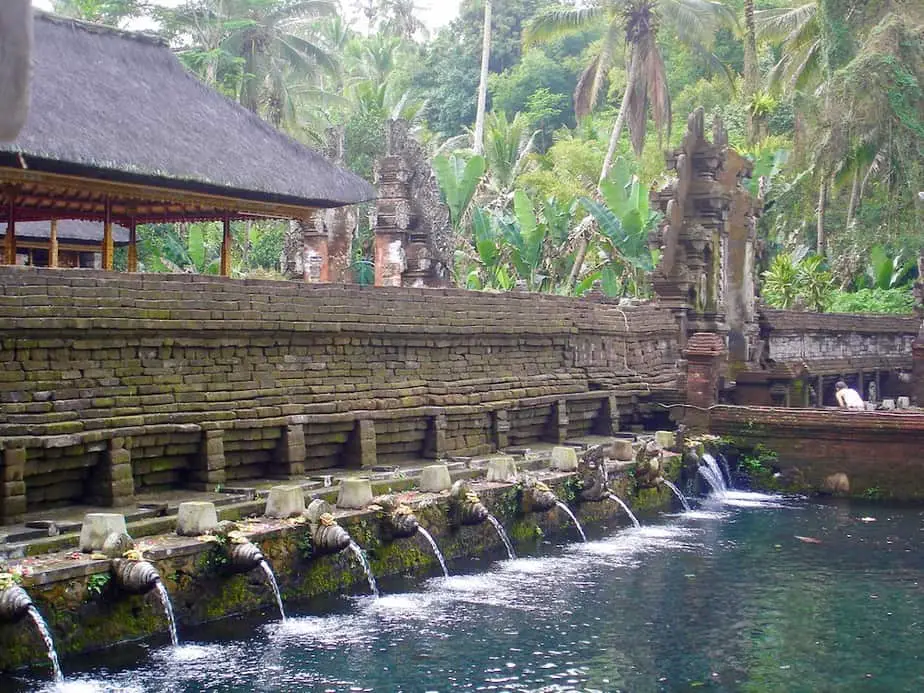
The Tirta Empul Temple is located in Tampaksiring and is one of the most popular temples among the Balinese and tourists. Many come here to cleanse themselves in the public bath, cure themselves of ailments or to get more luck in life.
There are separate baths for men, women, and priests. The holy water flows through 15 spouts and comes from the sacred springs on the other side of the wall.
- Winning point: It doesn’t matter if you are religious or not, anybody is welcome here to take a dip and take a moment.
- Tip: Always wear a sarong, not a bathing suit when you go into the baths. Come early as possible so you don’t have to wait in line.
- Entrance fee: The entrance fee to the Tirta Empul Temple is 50.000 Rph and includes a sarong and sash.
- Opening hours: The opening hours of the Tirta Empul Temple are from 8 am – 6 pm.
- Combine with: Best is to combine your visit with the nearby site of Gunung Kawi. The Goa Gajah Temple near Ubud is also worth a visit.
How to get to the Tirta Empul Temple?
Best is to hire a driver for a day to tour you around the island and stop at this temple. The brave can also rent a scooter and tour around but only when you’re advanced. Traffic can be tough when you come from the southern part of the island.
From Sanur to the Tirta Empul Temple takes around 55 minutes – 37,9 km. From Ubud, it’s only 27 minutes – 14,9 km. If you come from the Seminyak area, it’s around 70 minutes – 44,8 km.
Ulun Danu Bratan Temple
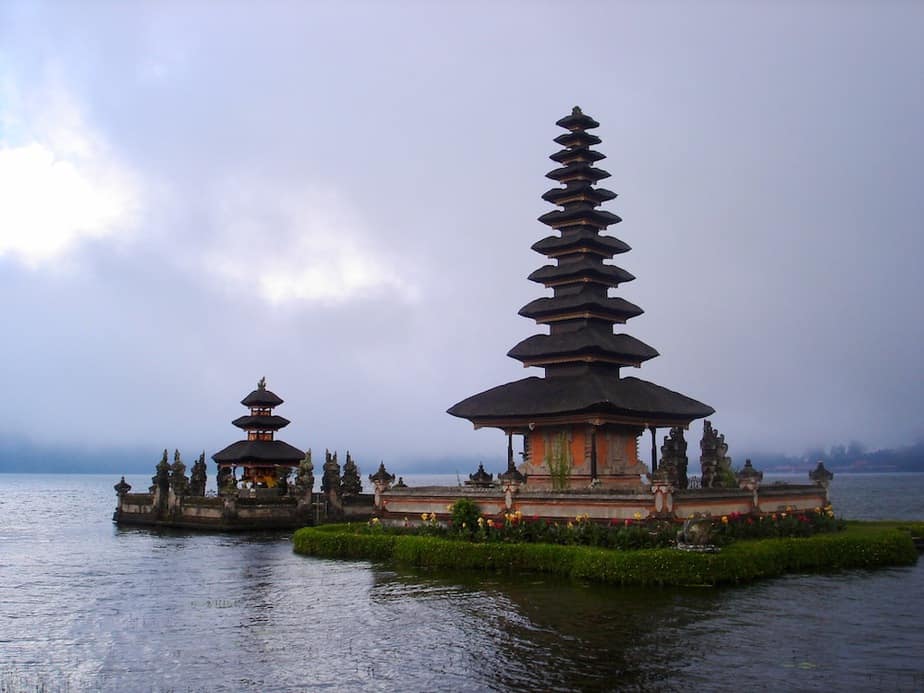
The Ulun Danu Bratan Temple is dedicated to the Goddess of water, Dewi Danu. She is very important to the Balinese people because she provides the water which is used in the irrigation of rice fields.
The temple was built in 1633 by the King of Mengwi, I Gusti Agung Putu. There are several shrines and two multi-tiered pagodas. The three-tiered pagoda is dedicated to Shiva. The eleven-tiered pagoda is built for the Goddess, Dewi Danu, and the God Wisnu.
- Winning point: This iconic temple is the only temple located on a volcanic crater lake in Bali. When facing the temple you can see the 2000m high walls of the extinguished volcano covered with mountain forest in the background.
- Tip: Try to come here as early as possible because then the sky is still clear and you can make some amazing pictures. It is also one of the most popular temples in Bali so the best is to visit before 10 am. Bring a jacket or jumper since it can get cold here.
- Entrance fee: The entrance fee to the Ulun Danu Bratan temple is 70.000 Rph for adults and 50.000 Rph for kids and includes a sarong and sash.
- Opening hours: The opening hours for the Pura Ulun Danu Bratan are from 7 am – 7 pm. On Saturdays from 5 am-7 pm.
- Combine with: A visit to Ulun Danu Beratan Temple is best combined with a visit to the Botanical Gardens 3km north of Bukit Mungsu, Lake Buyan and Lake Tamblingan, the waterfalls at Munduk and the Jatiluwih ricefields.
How to get to the Ulun Danu Bratan Temple?
From Sanur to the Ulun Danu Bratan Temple takes around 86 minutes over a distance of 58,2km. From Ubud, it’s 67 minutes – 44.4km. Coming from the Seminyak area the time to get to the temple takes around 75 minutes – 54km.
Kehen Temple in Bangli
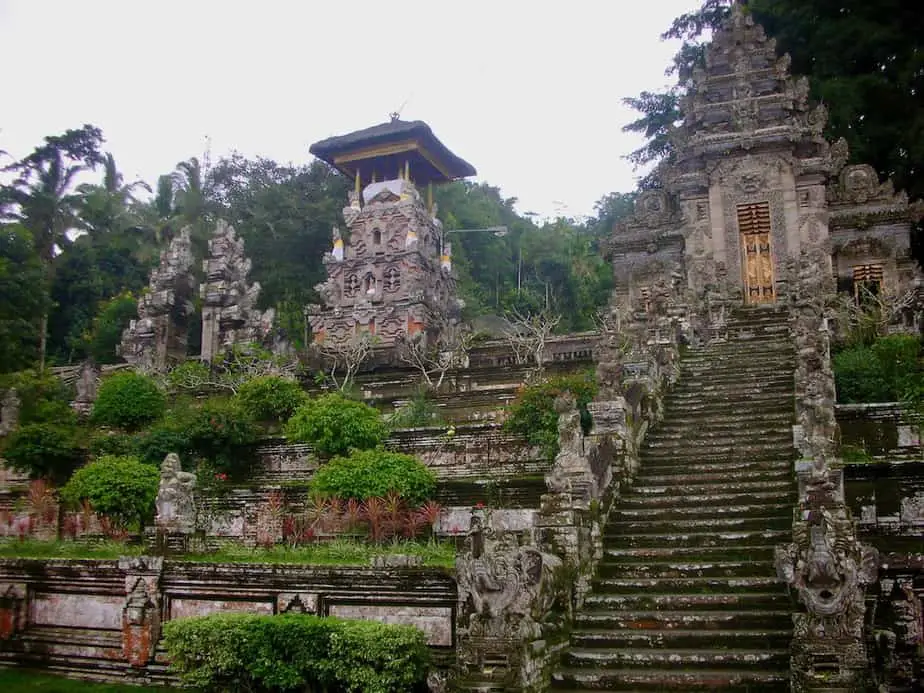
The Pura Kehen is built on a hill overlooking Bangli and made out of eight terraces and three courtyards. At the grand entrance of the temple, there are two elephant-headed barongs and many other statues that guard the temple. It takes 38 steps to reach the door to the temple.
The great thing about this temple is that you can have a look at every part of the temple. While at many temples in Bali you can’t access everything this is different at the Kehen Temple. It’s a hidden gem in Bali.
You can have a close look at the 11-tiered meru (thatched pagoda). The entrance to this pagoda is guarded by the stone lotus throne with two dragon heads and a turtle head.

The sacred old Banyan tree sits in the middle of the complex. Between the branches of this old Banyan tree, you can see the kulkul. The priest of the temple has to climb the tree first before he can hit the drum.
- Winning point: Of all the temples in Bali this is our favorite one because of the architecture and you can walk around freely. It hasn’t been discovered by many tourists yet which makes it the ideal place to observe the small details.
- Tip: Have a look at the carved doors and the decorative blue/white plates depicting Europeans.
- Entrance fee: The entrance fee to the Kehen Temple in Bangli is 30.000 Rph and includes a sarong and a sash.
- Opening hours: The opening hours to the Kehen Temple are from 8 am-5 pm.
- Combine with: A visit to the Kehen Temple is best combined with a visit to Pura Ulun Danu Batur, Mount Batur, and Batur Lake.
How to get to the Kehen Temple?
From Sanur to the Kehen Temple in Bangli takes around 57 minutes – 38,7 km. Travel time from Ubud to the temple is 41 minutes -24 km. And coming from the Seminyak area it’s around 72 minutes – 48,7 km.
Pura Dalem Jagaraga

The Pura Dalem Jagaraga (Temple of the Dead) and sometimes called Pura Dalem Segara Madhu is located 11.1km east of Singaraja, 4km inland from the main road between Singaraja to Amed.
Jagaraga is home to one of the deadliest battles between the Balinese people and the Dutch colonists.
The Dutch first arrived as traders but soon after turned into colonists which led to several uprisings. The first one was in 1846 and the second in 1848 which the Balinese won. It took the Dutch by surprise but they came back in 1849.
The traditional Balinese daggers and arrows were no match compared to the many Dutch bullets. The Balinese fought until death, also called ‘puputan’ in Balinese. Most of the area and the temple were destroyed.
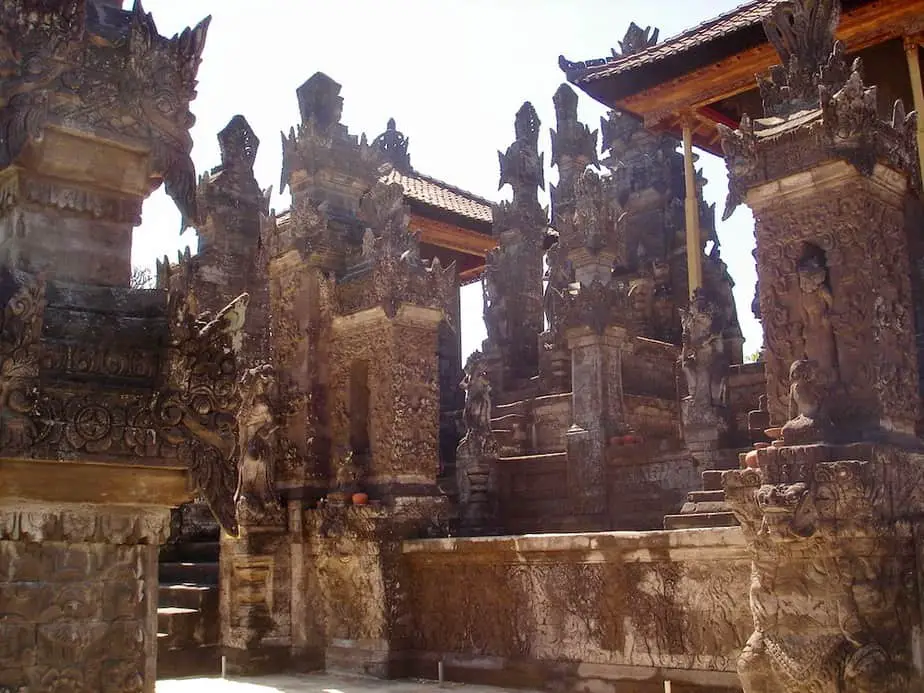
The Balinese had to rebuild their beloved temple and even renamed their village from Jagasari (watch out for your crops) to Jagaraga (watch out for yourself).
- Winning point: One side of the temple depicts how Balinese life used to be before the Dutch arrived. The other side when the Dutch tried to rule the island. You can clearly see that the Balinese made fun of their occupiers.
- Tip: Ask for the gatekeeper Ketut to show you around. He can tell you all about the little details. Don’t forget to give him a tip.
- Entrance fee: The entrance fee to the Dalem Jagaraga Temple is also by donation but 15.000/20.000 should be fine. Don’t forget your sarong and sash, otherwise, you can always rent one.
- Opening hours: The opening hours to the Dalem Jagaraga Temple are from 8 am -6 pm.
- Combine with: Try to combine your visit to this temple with the Pura Meduwe Karang nearby. Singaraja, Lovina Beach, and Munduk are good to combine too.
How to get to the Dalem Jagaraga Temple?
We don’t recommend going to this part of Bali when you’re on a day trip because you will be spending too much time in the car. It’s best to stay in either Munduk, Lovina Beach, or Amed Beach.
From Munduk to the Dalem Jagaraga Temple is 73 minutes -38.5 km. From Lovina Beach to the temple is only 30 minutes – 20km. From Amed Beach, it’s 1 H 47 minutes – 76.7 km.
Pura Meduwe Karang

The Meduwe Karang Temple is located 11.6km east of Singaraja in Kubutambahan village and is part of the Buleleng temples. The architecture is different compared to the other temples in Bali. The building materials used are different and the design is more flowery.
The temple was built in 1890 and is dedicated to the God Batara Meduwe Karang who protects the fertility of the agricultural land in the area. The temple is known for its beautiful carvings. The most famous carving is the Dutch cyclist W.O.J. Nieuwenkamp who cycled in Bali in 1904.
- Winning point: There is hardly anybody and chances are you will be the only tourist to visit the temple on that day. The carvings are of a very high level.
- Tip: Check out the carvings of the Lion King, the Hindu gods, and the Legong dancer.
- Entrance fee: This is one of the few temples where there’s no entrance fee but a donation is always welcome. Between 10.000 Rph-50.000 Rph is decent. You can also rent a sarong here.
- Opening hours: The opening hours to the Meduwe Karang temple are from 8 am -5 pm.
- Combine with: It is best to combine your visit to the Meduwe Karang Temple with a visit to Singaraja, Lovina Beach, and Munduk.
How to get to the Meduwe Karang Temple?
From Munduk it takes around 74 minutes over a distance of 45.1 km. From Lovina Beach, it’s only 33 minutes – 20.4km. From Amed Beach, it takes a while but it’s doable with 94 minutes with a distance of 71.7 km.
The Balinese people have created a unique mix of animism together with the Hindu religion. This is what makes the island unique with its many temples, shrines, and offerings. The smell of incense is everywhere on the island.
So when going to Bali a visit to the above temples should be on your list of things to do. You will get a better understanding of why the Balinese people are the way they are.

